#The South Bay Society
Explore tagged Tumblr posts
Text
E.T. Surf
904 Aviation Blvd. Hermosa Beach When I got out of my car there was a shaggy blonde headed guy with a squirt gun hiding behind a trash can apparently waiting for someone to come out the front door. We gave each other a nod as I scooted past in silence. Once inside I could see that there was no one anywhere near the door and for all I know that guy is still there waiting. There was a man behind…

View On WordPress
#California#ET Surf#Hermosa Beach#Los Angeles#menswear#SOuth Bay#style#surf#surf shop#surf style#surfer#The South Bay Society#TSBS
0 notes
Text
Wildflowers, Whales, and Wineries Western Cape South Africa
#Fernfloof Nature Reserve#Fynbos#Harold Porter National Park#Hemel En Aarde Hermanus Wine Route#Hermanus History Society#Karoo Desert National Botanical Garden#Onrus River Beaches#Overberg Western Cape#Postberg Flower Reserve#Quayside Cabin Restaurant New Harbor Onrus#Route 320 Hemel en Aarde Valley#Spring Wildflowers Western Cape#The Fynbos Guy#Walker Bay#West Coast Flowers South Africa#Western Cape South Africa#Whale Watching Western Cape
0 notes
Text

Tonight and Sunday #TrioOndine plays #SUBMERGED in Los Angeles: South Bay Chamber Music Society Series: 2/2/2024 – 8:00pm Los Angeles Harbor College 2/4/2024 – 3:00pm Pac.Unit.Church Rancho Palos Verdes https://sbcms.net/trio-ondine/ - Miguel del Aguila #concerts #chambermusic #classical #trio #flute #viola #harp
#Miguel del Aguila#Trio Ondine#Submerged#flute#viola#harp#South Bay Chamber Music Society#american composers#chamber music#Los Angeles
1 note
·
View note
Text
here's how armand can still be bengali
why do i think so? no other good reason than i am bengali myself and i want armand to be. (also assad zaman's family is from bangladesh. bengali solidarity!!!)
bengal: the region in south asia comprising present-day bangladesh and the indian states of west bengal, odisha, assam and parts of bihar.
armand said in the season one finale, that takes place in 2022, he is a 514 year old vampire. is it 514 years including or excluding his human years? let's go with including. that means armand would have been born in 1508.


now what was going on in india and bengal in 1508? well, the mughals hadn't come to india yet; it's still about two decades before babur makes his way here. delhi was under the rule of the lodi dynasty, the delhi sultanate was in its dying days. most of north india, mainly uttar pradesh and bihar was under the jaunpur sultanate. bengal was still it's own independent kingdom, called the bengal sultanate. alauddin hussain shah had just seized power and become the sultan of bengal in 1494, beginning the hussain shahi dynasty (they ruled in bengal till 1538 when the mughals captured the region).
india as a country did not exist yet. even it's conception would be a few centuries away still. the subcontinent was a collection of big and small kingdoms and sultanates, constantly warring amongst themselves, some ruled by hindu rulers others by muslims, each with their own distinct histories and cultures. bengal was one of the most prosperous and thriving among them. the bangla language and bengali culture was just beginning to develop.


vasco da gama had arrived in india in 1498, landing at kozhikode on the malabar coast. this began the arrival of the portugese in india, and soon other european colonialists followed. they soon set up their capital in goa, built forts all along the western coast and established trade through obtaining licenses and exclusive permits from local rulers. they first made their way to the bay of bengal region around 1516, with the first portugese representative- a guy called joao coelho- coming to chittagong (present day bangladesh). the first factory was set up in chittagong the next year.
the portugese traded in spices and cotton and fruits and muslin and also slaves. the european indian ocean slave trade began with the coming of the portugese in the early 16th century. slavery in south asian societies had obviously existed long before, and it was a deeply complex and diverse system of dependency and regimes of slavery. slavery of youth and children was also pretty prevalent: it would not be uncommon for poor, farming families to sell away themselves or their children to zamindars (landlords) and colonial overlords in desperation. there were many, many cases of young children being forced to get onboard ships where they'd be held agains their will and taken to europe, the americas or south-east asia. goa and lisbon were the two cities that linked the movement of goods and people between the indian and atlantic oceans, but goa wasn't the only place where enslaved children were traded in portugese india nor lisbon the only european they were taken to.
one of those kids might as well have been arun.


i know the brief glimpse at the talamasca files showed armand's origin to be in delhi but in this particular scene he clearly says that he was sent *to* delhi, thinking he was going to work on a merchant boat.
this is just a theory i have btw. armand could've been from maharastra or the deccan as well idk. anyway.
armand is a monster, a vicious, villanious creature of unfathomable powers and ferocity. but he is also so deeply tragic. he had been forcibly torn away from his people and his land. he has no memory of his family or his humanity. he has lived for over half a millenium. the india he might've known hasn't existed for centuries, and he never got to know the one that exists today. the bangla he might've spoken no one remembers anymore. he has nothing left of the human he was except that name.
further readings (STRONGLY SUGGESTED!!!):
267 notes
·
View notes
Text
British ships carrying plants and seeds from around the world arrived in Botany Bay on January 20 1788. This story is overshadowed by convict ships and Royal Navy vessels, but the cargo on board also had a lasting impact. Colonists, convicts and Indigenous Australians were all affected [...]. Some of these plants [...] were food sources [...]. Others were attempts to expand the British Empire. Could the new territory be exploited as a tropical plantation? In the parliamentary debate over destinations for convict transportation [considering potential locations for sending prisoners], Sir Joseph Banks and James Matra, both members of James Cook’s 1770 expedition [to the South Pacific], spruiked the potential of the new colony as an extension of the empire. Matra claimed the colony was “fitted for production” of “sugar-cane, tea, coffee, silk, cotton, indigo and tobacco”. Banks claimed Botany Bay was an “advantageous” site, with fertile soil [...].
Two plants carried by the First Fleet stand out as examples of botanical imperialism: prickly pear cactus (Opuntia) and sugarcane.
Banks, as head of the Royal Society of London [and as a close adviser to King George, and also as a plant-collecting botanist who turned the Royal Botanic Gardens at Kew in London into the world's leading botanical garden], selected these species as experiments to compete with European trade rivals. His goal was to break a Spanish monopoly in producing fabric dye and to expand British cultivation of sugar outside the West Indies.
Prickly pear cactus was imported because it is the preferred food of the cochineal insect.
Dried cochineal were crushed to make a vibrant, colourfast scarlet dye for textiles. Discovered in the New World by Spanish colonists, cochineal replaced kermes, another insect that had provided red dye since antiquity. Cochineal dye was ten times stronger than kermes or vegetable dyes.
From cardinals’ capes to British officers’ red coats, cochineal was a product for elite consumers signifying power, wealth and prestige.
New Spain, based in Mexico, had a monopoly on cochineal. Banks wanted to break the stranglehold on the scarlet dye by establishing production in New South Wales.
Plants infested with the precious insects were imported from Brazil in 1788. The project soon failed when the cochineal died, but the cacti survived. Colonists used cacti as natural fences and drought-resistant animal fodder.
Without insects to feed on them the plants spread, uncontrolled, to cover more than 60 million acres of eastern Australia by the 1920s. Poison, crushing and fire failed to stop the cactus. [...] Opuntia cacti remain an environmental hazard. [...] The roots of these early imperial projects are deeply embedded in Australian culture and history, with an enduring legacy.
---
All text above by: Garritt C. Van Dyk. "The botanical imperialism of weeds and crops: how alien plant species on the First Fleet changed Australia". The Conversation. 25 January 2024. [Some paragraph breaks/contractions added by me. Italicized text within brackets added by me for clarity and context.
#multispecies#tidalectics#ecology#archipelagic thinking#prickly pear in australia#british imperial forestry#ecologies#indigenous#indigenous pedagogies#black methodologies
439 notes
·
View notes
Text



















another NofNA style emulation comic, flashback style. this comic takes place 1 or 2 seasons after this comic. this one was to show Legend's first experience fighting and why she eventually came to start taking classes. she is a very stubborn character and i imagine without anyone telling her to do something else, she would have continued pursuing markscraftsmanship indefinitely. it was supposed to show a little bit of how she thinks in fights, but i think i could have done that part better.
you can see that she's walking home with a classmate who isn't a rodent. based on her dialogue, it seems like she was carrying supplies home herself instead of walking home with a rodent classmate until she befriended BY.
BY is a chacma baboon. he has a few unpleasant qualities, like cowardice and a lack of sensitivity toward Legend's insecurities, but from his perspective, he's just encouraging a friend who isn't confident in her talents and believes she's stuck trying to be a markscraft. there is a reason that he is studying to be a markscraft instead of going into fighting or a more important occupation like law or medicine; he wants a peaceful occupation where he supports other people who have to deal with the stressful stuff. they are sort of just past acquaintanceship -- they don't know each other very well. BY lives within escarpment south, like MK.
Legend lives in the same burrow, but the paperbark thorn is currently a smaller sapling, and there's less grass. the tree the leopard jumps from is a mountain hard pear (olinia emarginata). the shrub that BY hides under is a cancer bush (lessertia frutescens).
it bothered me as a kid (annoyed is maybe a better word) when predators who would chase the protagonists in shows and movies were sort of mindless killing machines, once i learned that they are somewhat selective and often risk-averse, because injury can be a death sentence for them, moreso than herbivores. a herbivore may be able to hide from predators until it heals; a predator can't hide from its need for food. i tried to give the leopard a richer... inner life than that. as Legend mentioned, she is deep past the wild-society border that's patrolled to keep wild predators like her at bay. she is aware of this. the expansion that BY mentioned is an expansion made primarily for an additional educational facility. i mentioned in the linked comic that i think markscraft classes are probably VERY populated, overflowing with students that faculty can't keep up with. the newer facility aimed to help ease the burden of educating a necessary labor force en masse. consequently, the area that the leopard is camping in is a footpath that connects the new writing college campus to a residential traffic junction which is used almost entirely by people who have no training in martial arts -- markscrafts. because the border is newer, there is probably more focus on patrolling the literal border around the campus than the paths connected to it. she is also aware of these things. in my head, she has observed many areas of their society for long periods of time (some more than others; no need to hang around an embassy to be noticed by the juiced guys with kill magic going in and out). she's absolutely picked people off here or there without the path, but she is rather desperate to be predating on largely rodents under half a pound when the consequences could be dire. when she sees two larger citizens on the path without the scent of rationale she has no hesitation. she jumped on the ratel instead of the baboon because the baboon had things stacked on his neck, and she wasn't sure how stiff they were or if she could bite through them right away. i don't know if she's ever hunted a ratel before, or if she simply knows their reputation secondhand, and thought it probably wouldn't be a problem with one coddled by society. i think she's under the belief that, unlike a smaller predator like a ratel, she is not diminutive enough to be welcome in society. it makes sense up front -- who wants to embrace the guy who ate grandma's face or dragged their baby off into the night? there is some powerful insecurity about feeling weaker than a collective group against her, and about the suggestion that there is something wrong with her way of living. i think she probably avoided them until food outside of the border became more scarce. i think wilds are shown as... "not knowing better"; in the addendum of secretary, it's put as "not thinking about the options they might have" -- but we are shown many wilds who know about society. they all seem to at least KNOW about it. they know that there is technically a way to enter it. so they DO know it's an option. it's just an option that's less palatable than killing people. and i wanted to write this leopard like that. i didn't really want her to be a hapless ignorant animal looking for food. food is absolutely part of it, but leopards in particular are very adaptable. she could just as well hunt other predators or pets and livestock near human society, but she has beef (not pun intended). i mentioned that Legend's parents raised her to be sympathetic to wilds, so here she is under the belief that this leopard would not eat people if she simply had Enough Information. who's to say? but she certainly doesn't lack ALL information about it. wilds seem to have a belief that being eaten by an opponent stronger than oneself allows you to become part of the stronger force. NOT eating someone is a grave insult (to predators, anyway, idk how prey species feel about that), and i think sparing her altogether is probably just rubbing salt in the wound about her insecurities wrt society being "better than her."
222 notes
·
View notes
Text

The restless wind had rushed through the tall spruces all night, and by the morning it had swept the drenching Scotch mist far, far away… for the moment, at least…
And, much to Algy's astonishment – for the weather birds had told him that it would remain misty and wet all week in the wild west Highlands of Scotland – the sun was beginning to shine. However, the rather-too-brisk south-westerly was ruffling his feathers in a way that was considerably less than pleasant in the cool January air, so, like many of his smaller feathered friends, Algy decided to seek cover in a dense, evergreen bush.
He knew that some of them favoured the handsome bay tree which grew in a sheltered spot in his assistants' garden, so he decided to try it for himself. Settling down on its dense branches, Algy found that it did indeed afford a great deal of protection from the wind, and the invigorating aroma of its leaves, which continued to glow bright green, even in the depths of winter, lifted his winter-weary spirits. Relaxing happily in the arms of the welcoming bush, Algy began to recite, for the benefit of any smaller birds nearby who might not have the advantage of a good literary education:
How vainly men themselves amaze To win the palm, the oak, or bays, And their uncessant labours see Crown’d from some single herb or tree, Whose short and narrow verged shade Does prudently their toils upbraid; While all flow’rs and all trees do close To weave the garlands of repose. Fair Quiet, have I found thee here, And Innocence, thy sister dear! Mistaken long, I sought you then In busy companies of men; Your sacred plants, if here below, Only among the plants will grow. Society is all but rude, To this delicious solitude. No white nor red was ever seen So am’rous as this lovely green. Fond lovers, cruel as their flame, Cut in these trees their mistress’ name; Little, alas, they know or heed How far these beauties hers exceed! Fair trees! wheres’e’er your barks I wound, No name shall but your own be found.
[Algy is reciting the first three verses of the poem The Garden by the 17th century English metaphysical poet and politician Andrew Marvell.]
#Algy#photographers on tumblr#writers on tumblr#Scotland#bay tree#Scottish Highlands#Scottish weather#andrew marvell#poem#poetry#english metaphysical poetry#green#evergreen#the garden#laurus nobilis#fluffy bird#january#sunshine#vanity#lifting the spirits#nature#encouragement#storybook land#whimsy#peace#quiet#trees#repose#original content#original character
85 notes
·
View notes
Text
Speculations for Caleb's myth based on what we Know So Far (Dawnie's Version) (Infold please don't sue me)
Disclaimer: THIS IS ALL PURE SPECULATION after discussing with the caleb gc and i thought i would share it here, too‼️

CalebMc is not your typical love story because of two things:
Caleb’s established relationship with her
Infold’s commissioned art depicting CalebMc as the seduction of eve
ESTABLISHED RELATIONSHIP
Caleb and Mc were both adopted by Josephine, though it is noted that he does not share the same family name as her and retains his own surname (Xia). However, due to the close nature of their relationship, it is not socially acceptable to simply just show his love to Mc… but what if there’s something deeper?
SEDUCTION OF EVE
Eve is a biblical figure known to be the first mother of humankind. During her time in the Garden of Eden, she is seduced by the potential knowledge from the serpent. Most interestingly, Infold has commissioned a drawing of Mc and Caleb in this exact scenario which implies:
Caleb has knowledge Mc wants
The desires within the both of them need a catalyst to grant them that knowledge
OR
Caleb is being set up as someone to corrupt MC.
BUT, WHO IS CALEB?
He is shown to be someone kind and charismatic, witty and good at cooking. It is implied he is a charmer and is highly intelligent due to his high-risk job as a fighter pilot in the Deepspace Aviation Academy.
WHAT HAPPENED TO HIM?
After the explosion, Caleb is presumed to be dead. However, with his name already listed in the beta, it is highly probable for us to deduce that he will be returning back to the game. Further proof: In the trailer for the Visions Opposees music video, we see a man falling from the sky after the 4 LIs are shown with MC. There is some speculation that this might be Caleb.
As he falls between time and space, there are suspicions that because of his Evol or the Spatium Protocore, he is currently in a different plane of existence.
But, where he is or when he will come back is not what we’re here to discuss. We’re here to speculate about his myth.
THE MYTH OF THE WHITE SNAKE
Snakes are an important figure in Chinese myths, and the biggest one is Bai Suzhen. She is a white snake spirit who became immortal and could take human form and is the main character in the Legend of the White Snake, one of China's four great folktales. She notably met her husband in a past life and risked her life to steal herbs from the monk of the South pole to revive him back from the dead.
THE COWHERD AND THE WEAVER
Another big Chinese myth. This one centers around forbidden love between a celestial weaver and a cowherd. Long story short, she returned back to the heavens after living a life with him and bearing him two children, but because of her grave error in tarnishing herself with humans, the gods separated them by heaven and earth—forcing a milky way between them. They are only allowed to meet once a year by crossing a bridge of magpies.
SPECULATIONS FOR CALEB'S MYTH
If we follow Infold’s style according to the other LIs’ myth, MC is always someone who is shunned and ostracized by society in order to set up a connection between her and the LIs. However, taking into account all the myths listed above running in the same vein as Caleb’s general vibe, they have one thing in common: forbiddenness.
Forbidden love. Forbidden knowledge.
Mirroring Caleb’s love for MC which is forbidden because they were raised together.
What I speculate is this:
MC is someone who is of high importance and meets Caleb through a chance encounter. Her life is sheltered and she yearns to learn more—to experience more (kind of like Abysswalker’s MC). But, she is not used for the powers of her Aether core, and is sheltered from that knowledge. Enter Caleb who has an inkling of what she is and what is her potential. He shows her a different world, one where she can’t be used as a pawn in anyone's game and gives her a taste of true power. In turn, she becomes drunk on it and seeks him out more to learn about her true purpose.
Somehow, they fall in love with each other and he admits his feelings. But, what she doesn't know is he has a different form, and only lives among humans to [insert motive because I am not Infold’s writer goddamnit]. However, something happens to her and she gets seriously injured. To save her from the brink of death, Caleb has to steal something from a deity or whatever. He goes to the heavens and steals a herb that can bring her back to life but unbeknownst to him, MC is actually the child of a god/higher up being/etc and this could be alluded to be Josephine.
Knowing what he has done to her granddaughter, the Queen Mother Cvnt of heaven casts him away and keeps him from MC in the heavens, where she thinks he has abandoned her during her weakest moment. Someone saves her and it's Josephine, who brings her back to life but only poisons her thoughts about Caleb as the subsequent days go by.
But, seeing how much Caleb loves MC, her heart softens and she allows them to meet once a year, under her watchful eye (EVER WHAT’S UP).
….. Okay that’s it…. That is the only way I can connect the dots.
THE END
#caleb xia yizhou#caleb love and deepspace#love and deepspace#caleb lads#xia yizhou#myth speculation#dawn.txt
118 notes
·
View notes
Text
The socio-ecological contradictions of the capitalist mode of production can be handled as long as it is possible to externalize its costs to non-capitalist or less developed capitalist spaces and valorize labour power under poor conditions. This is precisely what the global North, despite all differences and asymmetries within its respective societies, has benefited from for so long. It has appropriated the resources of the global South and at least partially returned waste and emissions from industrial production and consumption. It has therefore been able to keep the socio-ecological consequences of its own mode of production at bay. The global North’s imperial mode of living is based on social and ecological exclusivity. It presupposes that not all people enjoy equal access to the Earth’s resources and sinks. Only some people can externalize costs across space and time. Paraphrasing the classical theory of imperialism, developed capitalism needs a non-capitalist or a least a less developed outside in order to keep it from foundering on its own ecological contradictions.
The Imperial Mode of Living: Everyday Life and the Ecological Crisis of Capitalism
75 notes
·
View notes
Text
Fandom Opinion Chart + Explanations Under the Cut
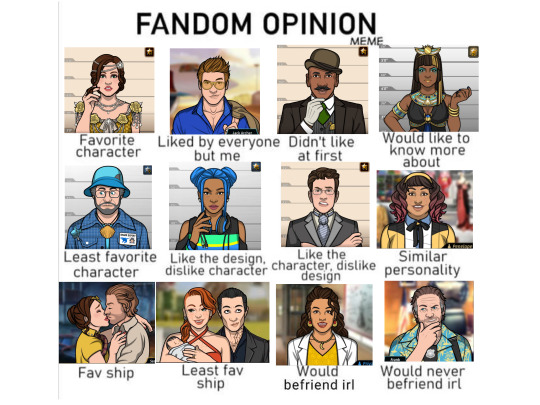
I love Giulietta, it's as simple as that,,, her character growth from her selfish attitude towards her sister before the game, to trying to make her way into high society, to returning to her roots but finding love in a man supposed to be her enemy, to trying to stop the gang war that takes almost everything from her, to later leading a resistance against a dictator is incredible to watch. She's the real main character of Crimson Banks and Capital Peak idc. She endures so so much heartache, I cried both times I played In Love and War, that case genuinely makes me feel ill, and yet she manages to get back up because she's just that strong. I hope she was happy after the game ended.
On the other hand, I despise Jack. He makes several sexist comments throughout the game (I've half a mind to compile them to prove my point), and I have no idea how someone as immature and annoying as him managed to get a job in Interpol. His relationship drama with Asal is insufferable to sit through, and the way he constantly whines about her in South America and North America months after they broke up made me want to throw my phone, especially with the awful way he treats her after she's stabbed and almost died. And then in Travel in Time, he's just boring.
I initially didn't like Samson at first because he killed one of my favorite characters for a stupid reason (accompanied by a confusing message--how was Malcolm supposed to know Archie's death was targeted towards him?) but now I love him because his plan was so dumb and he's fun to meme on and he's REALLY hot.
Nebet is like my favorite main antagonist and it's so sad that she's gone for like two whole districts because even though I saw it coming, her betrayal HURT. Like 99% of s6's writing effort went into her, and she would have been a good antagonist even if she hadn't returned after killing her father, but the fact that she comes back and kills her younger self because she changed in exile makes her such an interesting character. I want to know so much about her, her thoughts while she was working with the team, and especially her epiphanies in exile, how she changed in exile and decided to turn against her parents and their goals. That's incredible fanfic material. She's also incredibly beautiful just LOOK AT HER.
Trevor Finn sucks. Fake af shark "expert" who probably just gave himself that title after watching Jaws but never bothered doing any research about sharks because he just spews misinformation and stereotypes about sharks that aren't true. For some reason, Pacific Bay really hated sharks. But other than that, there's not much else to mention about him, when with Jack I at least have stuff to complain about.
I realllly don't like Rozetta and do NOT think she was redeemed, even if Denise was a greater evil. I feel like people brush over the fact that she was KIDNAPPING AND TORTURING HOMELESS PEOPLE TO DEATH. She abducted who knows how many people and conducted horrific, torturous human experimentation on them that only one person (Zoe) survived, and nothing indicated she felt any remorse for those crimes, she only started fighting against Denise when Denise betrayed her and her friends. And even though Zoe escaped, Rozetta started the chain of events that led to Zoe's death. However, that being said, Rozetta is really, really pretty.
Archie is a millionaire and yet he dresses so drab. Lawson isn't as rich as Archie, and yet he dresses more fancy. Also Archie's collar looks weird and like his tie would be strangling him or something
I don't really talk about Penelope, but she (besides Nebet) is my favorite main character of s6! I relate to her a lot because we both like history and writing. I think we'd get along great talking to each other about story ideas, fangirling about fandoms, and talking about history.
Seamus x Giulietta is my favorite because Giulietta is my favorite character and I'm a sucker for tragic, star-crossed lovers. Got really emotionally attached to them even though I knew they wouldn't have a happy ending. Honorable mentions go to Arthur x Bernadine, Archie x Elisa, and Hope x Gwen.
Speaking of Hope x Gwen, they should have been canon instead of Gwen x Pierce. I hate this ship so much. Hope and Gwen had much more chemistry, and the FIRST DISTRICT in s7 proved why Gwen and Pierce wouldn't work out, and then out of nowhere Pierce shows up??? And gets back with Gwen randomly??? Huh??? And they have a kid??? Why. Hope was RIGHT THERE if you wanted someone to comfort Gwen after her mother's death and the complicated relationship she had with her.
I also don't talk about her as much as I should, but I love Priya! I love her character arc, her relationship with Zander is very sweet and well built up throughout the season, and her being a werewolf made her character arc all the more interesting. She's also just a very genuinely kind person, and I feel like she would have been a really good chemistry tutor when I was struggling with it in school lol
Given how annoyed I get with classmates and coworkers who are poor communicators, I would despise being around someone like Frank who's always late, drinking whenever he can, and who treats his female boss incredibly disrespectfully. Plus he eventually becomes a corrupt police officer and yeah, not a fan of those. Wouldn't want to be around one irl. He certainly needs professional help, but I am not the one to give it.
#criminal case mysteries of the past#criminal case#criminal case game#criminal case the conspiracy#criminal case travel in time#criminal case pacific bay#criminal case supernatural investigations#criminal case save the world
27 notes
·
View notes
Text
Good News - May 1-7
Like these weekly compilations? Support me on Ko-fi! Also, if you tip me on Ko-fi, at the end of the month I'll send you a link to all of the articles I found but didn't use each week - almost double the content!
1. New study says conservation works, providing hope for biodiversity efforts
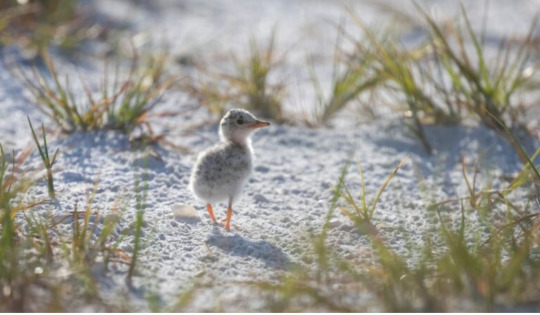
“A new study published in Science reveals that conservation works, with conservation actions improving or slowing the decline of biodiversity in two-thirds of the cases analyzed.”
2. Monk Seal Pup Debuts in Waikīkī on Lei Day
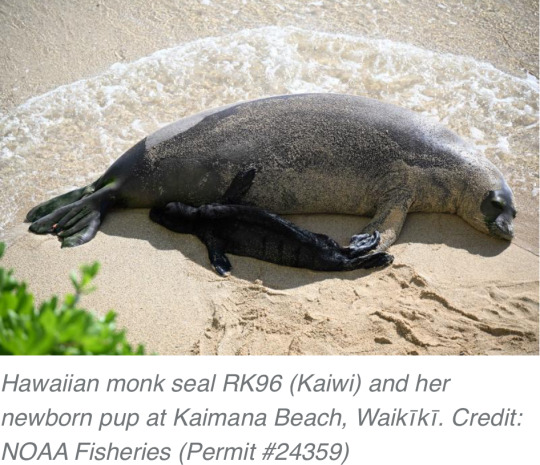
“Endangered Hawaiian monk seal RK96 (Kaiwi) gave birth to her sixth pup on popular Kaimana Beach in Waikīkī, Oʻahu! […] Hawaiian monk seals are one of the most endangered seal species in the world, so each pup represents hope for the species’ recovery.”
3. West Coast Indigenous-led marine conservation area gets global spotlight
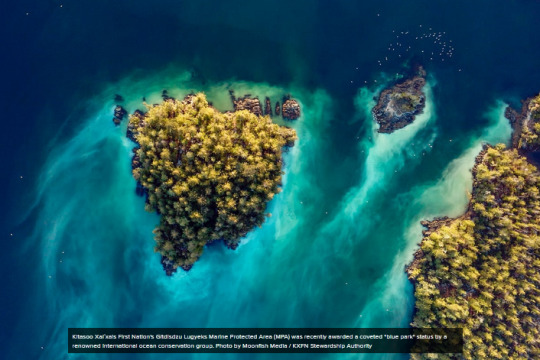
“A coastal First Nation is celebrating global recognition of its marine protected area after recently snagging a “blue park” designation that highlights exemplary ocean conservation efforts around the world. […] Kitasu Bay supports one of the last abundant herring spawns along the central coast, vital to the nation’s communal herring roe on kelp (ROK) fishery - which harvests the protein-rich eggs but leaves the fish alive to flourish and spawn again.”
4. The number of fish on US overfishing list reaches an all-time low. Mackerel and snapper recover
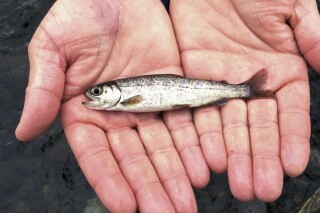
“The report states that 94% of fish stocks are not subject to overfishing, which is slightly better than a year ago. The U.S. was able to remove several important fish stocks from the overfishing list, NOAA said in a statement. […] The removal of species from the overfishing list shows the U.S. is making progress, said Rick Spinrad, NOAA’s administrator.”
5. Researchers Collaborate with the Shipping Industry to Cut Costs, Fuel Consumption and Greenhouse Gas Emissions in Shipping
“Through coordinated ship scheduling and an optimisation of ship operations and port services, the objective is to achieve a substantial increase in energy efficiency and a 10-20% reduction in fuel consumption, consequently resulting in lowered greenhouse gas emissions [and] leading to substantial economic benefits for shipping and environmental advantages for society[….]”
6. The city flower farm that is changing lives
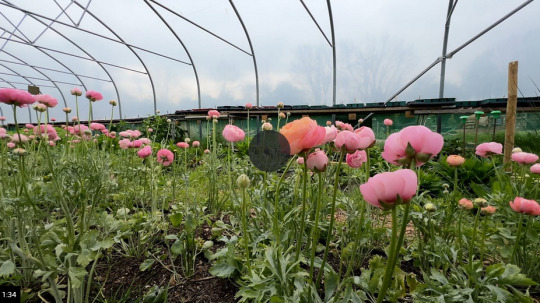
“Heart of BS13 Flowers in Hartcliffe is part of the wider Heart of BS13 charity which tackles food insecurity in south Bristol. Profits from the flower sales to run workshops, offer volunteer and trainee placements, and create education opportunities for people from Hartcliffe.”
7. Four falcon chicks hatch in Glasgow university tower
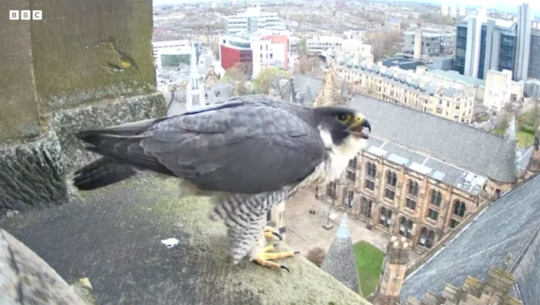
“Members of the [Glasgow Peregrine] project hope to […] fit [the chicks] with electronic tags that will enable monitoring of their movements. Mr Simpson added: "With the identification tags we can see where they have gone, how high they fly and other information that would be really useful." In recent years the group have held peregrine watches at the university, allowing people to see the birds in their nest.”
8. 'Banana pingers' are saving whales and dolphins around the world
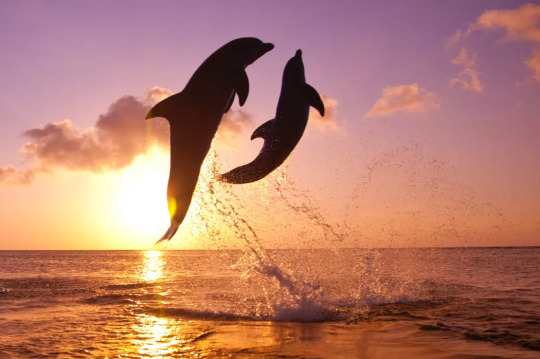
“[T]he Kibel brothers, Pete (a fisheries biologist) and Ben (an engineer) […] have been utilising light to protect turtles, sound to protect porpoises and electro pulses to protect sharks. [… Trials] showed reduced average catch rates of blue shark by 91%, and catch rates of pelagic stingray by 71% […as well as] a fall in the number of sea turtles being trapped by 42%.”
9. New vaccine effective against coronaviruses that haven't even emerged yet
“Researchers have developed a new vaccine technology that has been shown in mice to provide protection against a broad range of coronaviruses with potential for future disease outbreaks -- including ones we don't even know about. […] The new vaccine works by training the body's immune system to recognise specific regions of eight different coronaviruses, including SARS-CoV-1, SARS-CoV-2, and several that are currently circulating in bats and have potential to jump to humans and cause a pandemic.”
10. Grassland birds, Forest birds and Other Migratory Birds to Benefit from More Than $22 Million in Funding Throughout the Americas
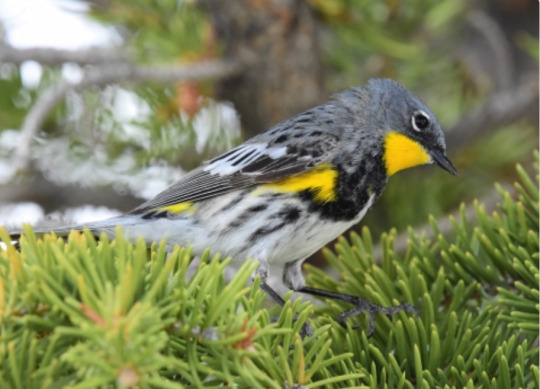
“This year, more than $4.87 million in federal funds will be matched by more than $17 million in partner contributions going to 30 collaborative conservation projects in 19 countries across the Americas. “These investments will [… protect] millions of acres of diverse habitats needed by grassland birds, forest birds and shorebirds for wintering, breeding and migration,” said Service Director Martha Williams.”
April 22-28 news here | (all credit for images and written material can be found at the source linked; I don’t claim credit for anything but curating.)
#good news#hopepunk#sorry its late i got distracted lol#biodiversity#conservation#seal#monk seal#hawaiʻi#oahu#first nations#fish#noaa#shipping#climate change#greenhouse gasses#ships#flowers#falcon#glasgow#university#peregrine falcon#birds#whale#dolphin#shark#turtles#vaccine#coronavirus#health#animals
21 notes
·
View notes
Text
African Gods, African Goddesses & African Mythology Guide – Culture Bay
The vibrant lore of African deities and mythology contributes greatly to the richness of cultural traditions. The pantheon plays a pivotal role in African culture, embodying the values, beliefs, and customs of various communities. It's more than just deities; it's a reflection of societal norms and historical narratives.
The diversity within the African pantheon further enhances its depth, offering unique insights into different ethnic groups across the continent. This starter guide aims to give you an overview of this fascinating aspect of African culture that continues to shape identities and influence contemporary thought.
Table Of Contents
Key Takeaways
The Origins and Diversity of African Mythology
Prominent Deities in African Mythology
The Diversity of Beings in African Mythology
Beauty and Significance of African Mythology
Exploring Yoruba Mythology and Deities
Ancestral Spirits and Nature Beings Across Africa
The Influence of African Gods on the Diaspora
Moral Teachings and Aesthetic Expressions in African Myths
Syncretism in African Diaspora Religions
Cosmic Tales and Creation Myths in Africa
Oral Tradition and Storytelling in African Mythology
North, South, East, and West: Diversity of African Folklore
The Impact of Egyptian Mythology on African Beliefs
Exploring Bantu and Kuba Creation Myths
Santeria: A Deeper Dive into Afro-Caribbean Faiths
Exploring Afro-Brazilian and Haitian Vodou Deities
The Mysteries of Oshun, Nana Buluku, and Oya
Understanding the Powers of Shango, Obatala, and Olokun
Exploring the Stories of Yemoja, Elegua, and Babalú-Ayé
Pan-African Historical Legends: A Comparative Study
Conclusion
Frequently Asked Questions
Key Takeaways
African mythology is a rich tapestry of tales and teachings, with each region offering unique deities and spirits that reflect the continent's immense cultural diversity.
The Orishas of the Yoruba tradition, such as Oshun and Shango, are central figures that embody various aspects of life and nature, and their stories provide valuable insights into Yoruba beliefs and values.
Ancestral spirits play a critical role across many African cultures, emphasizing the importance of lineage, respect for elders, and the interconnectedness of the living and the spiritual realms.
Understanding the impact of African gods on the diaspora reveals how these mythologies have adapted and survived through syncretism in religions like Santeria and Vodou, especially in the Caribbean and South America.
Anansi the Trickster is a key figure in African folklore whose stories underscore the significance of intelligence and cunning over brute strength, teaching moral lessons that resonate across various African societies.
The oral tradition remains a vital part of African mythology, ensuring the preservation and transmission of these stories through generations, which continue to influence modern culture, art, and religious practices.
The Origins and Diversity of African Mythology
Historical Roots of African Mythology
The intricate web of African mythology has its roots in the very beginnings of civilization. These mythologies, deeply ingrained in the cultural fabric, were a way for early societies to make sense of their world and existence.
The myths served as moral compasses, guiding people through life's challenges and uncertainties.
Take for instance, the Yoruba tribe in West Africa. Their mythology revolves around a pantheon of gods and goddesses, each responsible for different aspects of life. One such deity is Olorun, the sky god believed to have created the universe.
Variety in Myths Across Different Regions
Moving from one region to another within Africa reveals a diverse array of myths. This diversity is reflective not just of geographical boundaries but also distinct ethnic groups and cultures.
In North Africa, Egyptian mythology holds sway with its famous gods like Ra (the Sun God) and Isis (the Goddess of Magic). Meanwhile, southern Africa has its own unique set including Mukuru - revered by the Himba people as an ancestor spirit who intervenes on behalf of humans.
Influence Of Geography On Mythological Narratives
Geography plays a significant role in shaping these mythologies. From river valleys to arid deserts, every landscape has influenced local myths in one way or another.
Consider how Nile River shaped Egyptian mythology. The annual flooding was attributed to Hapi - the god of inundation – ensuring fertile lands for agriculture.
Similarly, among the Maasai tribes inhabiting East Africa’s savannahs, Enkai is worshipped as both sun and fertility god – demonstrating how geography influences divine attributions.
Prominent Deities in African Mythology
Key Gods and Goddesses in Africa
Africa is rich with numerous gods and goddesses, each playing a significant role in the life of their believers. Among them, Amun-Ra, the creator god of ancient Egypt, stands out prominently. He was worshipped as the king of gods and symbolizes creation.
Anansi, another key deity from West Africa, is renowned for his wisdom. Often depicted as a spider, he is associated with storytelling and trickery. In Yoruba mythology from Nigeria, Oshun is revered as the goddess of love, fertility and rivers.
Roles and Significance of These Deities
Each African god or goddess holds a unique role within their respective cultures. For instance, Amun-Ra was considered the supreme power responsible for creating everything in existence. His significance extended beyond spiritual beliefs into political realms; Pharaohs often claimed to be his descendants to legitimize their rule.
In contrast to Amun-Ra's grandeur, Anansi plays a more down-to-earth role as a cultural hero. His stories are used to teach morals and social values to children.
Oshun's importance lies in her connection with fertility and prosperity. She provides hope for childless couples and blesses them with offspring.
Unique Attributes Associated With Each Deity
Each deity possesses unique attributes that distinguish them from others. Amun-Ra embodies duality; he represents both hidden (Amun) and visible (Ra) aspects of life.
Anansi’s primary attribute is intelligence; his cunning ways make him an interesting character in folk tales.
Oshun personifies love and beauty; she manifests through sweet waters like rivers or streams where devotees perform rituals to seek her blessings.
The Diversity of Beings in African Mythology
African mythology is rich with a variety of beings, each with unique characteristics and roles in the natural and supernatural worlds. These beings often serve as deities, spirits, and creatures in African folklore, shaping the cultural and religious beliefs of various African tribes and communities. Here, we explore some of the most prominent types of beings in African mythology.
Gods and Goddesses
In African mythology, gods and goddesses are the supreme beings who rule over the universe. They are often associated with natural elements like the sun, moon, earth, and water. Notable gods include Amun-Ra, the Egyptian sun god; Olorun, the Yoruba god of the sky; and Mawu, the Ewe goddess of the earth and moon.
Ancestral Spirits
Ancestral spirits are revered in African mythology as they are believed to have a direct influence on the lives of the living. They are often invoked for guidance, protection, and blessings. An example of this is the veneration of ancestors in the Zulu tradition.
Nature Spirits
These are spirits associated with natural elements such as rivers, mountains, trees, and animals. They are believed to inhabit these elements and can either bring fortune or misfortune. The Yoruba river goddess Yemoja and the Igbo earth goddess Ala are examples of nature spirits.
Mythical Creatures
African mythology is replete with mythical creatures, often embodying both human and animal traits. These include the Anansi, a trickster spider from Akan mythology; the Sphinx, a creature with a human head and a lion's body from Egyptian mythology; and the Mokele-mbembe, a dinosaur-like creature from Congo River basin folklore.
Demonic Beings
In the realm of African myth, entities symbolizing wickedness or bad luck are prevalent. One such example is the Tikoloshe, a small water spirit resembling a dwarf.
Beauty and Significance of African Mythology
The allure of African mythology is in its elaborate mix of narratives, figures, and mythical features. These lively stories do more than just amuse; they teach valuable lessons about life, ethics, and our environment.
Aesthetic Expressions in Myths
The myths play a significant role in shaping aesthetic expressions. The narratives inspire various forms of art such as sculpture, painting, and dance. For instance:
Sculptures often depict gods and goddesses from mythology.
Dance routines are choreographed to tell the story of a particular myth.
Paintings portray scenes from these myths.
These artistic representations bring to life the beauty inherent in African mythology. They provide a visual narrative that complements oral storytelling while adding an extra layer of appreciation for the depth and complexity of these myths.
Moral Teachings within Communities
African mythology is an important tool for moral instruction within communities. These stories often contain lessons on virtues like honesty, bravery, kindness, and respect for elders. For example:
The Yoruba god Shango teaches about justice and wrath.
Anansi the spider from Akan mythology emphasizes wisdom and cunningness.
Maasai's lion-god Nemele teaches about bravery.
Through these stories, children learn about good behavior while adults are reminded of their responsibilities towards society.
To See The CHART click the title to visit the page directly
Exploring Yoruba Mythology and Deities
Overview of Yoruba Mythology
Yoruba mythology is a rich tapestry of tales, beliefs, and traditions. Originating from the Yoruba people in West Africa, it has influenced cultures worldwide.
The Yorubas believe in a pantheon of gods and goddesses, each governing different aspects of life. These mythical beings are revered for their divine powers and wisdom.
For instance, Ogun, known as the god of iron and warfare, symbolizes strength and courage. His influence extends to professions that involve metalwork like blacksmithing and surgery.
Similarly, Osanyin is another important figure in Yoruba mythology. As the god of herbal medicine, he represents healing and protection against diseases.
Key Figures in Yoruba Pantheon
In addition to Ogun and Osanyin, other key figures populate the Yoruba pantheon. One such figure is Oduduwa.
Oduduwa holds a special place as he's considered the progenitor of all Yorubas. He's associated with creation myths where he descended from heaven to create the earth at Ile-Ife, now regarded as the spiritual home of all Yorubas.
Another notable deity is Oya. She's revered as a goddess who governs winds and storms—a symbol of drastic change.
Moreover, divination plays an essential role in connecting with these deities. It involves rituals where priests interpret signs or symbols to reveal divine messages or prophecies.
Cultural Impact of Yoruba Myths
Yoruba myths have left an indelible mark on various cultures globally through migration and diaspora communities—especially in countries like Brazil, Cuba, Trinidad & Tobago where African religions mixed with Christianity led to syncretic faiths like Candomblé or Santería where many African gods found new identities.
For instance, in Brazil's Candomblé religion, Ogun is syncretized with Saint George—both sharing attributes of a warrior. Similarly, Osanyin is often associated with Saint Joseph or Saint Sebastian, reflecting their shared association with healing and protection.
Yoruba mythology also significantly influences art, music, and literature. For example, Nigerian author Wole Soyinka's works often incorporate Yoruba myths and legends.
Ancestral Spirits and Nature Beings Across Africa
The Role of Ancestral Spirits
Ancestral spirits hold a significant place in many African cultures. These entities, often deceased family members, are believed to influence the daily lives of the living. They provide guidance, protection, and blessings to their descendants.
For instance, in Saharan Africa, ancestral spirits are revered and consulted for wisdom during important decision-making.
The belief in these spirits is deeply ingrained in African societies. It transcends generations and forms an integral part of their cultural identity.
Their presence is felt through rituals that honor them - from simple offerings at home altars to grand festivals celebrated community-wide.
Nature Beings and Environment Connection
In addition to ancestral spirits, nature beings also feature prominently in African mythology. These beings embody natural elements like rivers, mountains, trees, or animals. They symbolize the intimate connection between humans and their environment.
Nature beings are considered guardians of specific natural elements they represent. For example, a river deity would be responsible for maintaining the balance of aquatic life within its domain.
These entities remind people of their duty towards environmental conservation. By venerating nature beings, communities show respect for nature itself - preserving forests as sacred groves or protecting certain animal species seen as incarnations of these deities.
Rituals Associated with Spirits and Nature Beings
Rituals form an essential aspect of engaging with both ancestral spirits and nature beings across Africa. They range from personal prayers at home shrines to elaborate ceremonies involving music, dance, sacrifices, or processions.
For instance, during harvest season in many agricultural societies across Africa, rituals are performed to thank the ancestral spirits for bountiful crops while seeking blessings for future harvests.
Similarly, before embarking on a fishing expedition or hunting trip - activities closely linked with survival - people might offer prayers or sacrifices to nature deities seeking success and safety.
The Influence of African Gods on the Diaspora
Migration and the Spread of African Mythology
The migration of Africans, forced or voluntary, to different parts of the world had a significant impact on the spread of African mythology.
People carried their beliefs with them, including stories about their gods and goddesses. These narratives found new homes in various corners of the globe, from the Americas to Europe.
For example, during the transatlantic slave trade, enslaved Africans brought their religious practices to North and South America.
Over time, these practices evolved into unique belief systems like Vodou in Haiti and Candomblé in Brazil. Both religions feature African gods known as Loa (Vodou) or Orishas (Candomblé).
Adaptation of African Gods in New Cultural Contexts
In new environments, these deities adapted to resonate with local cultures. This fusion resulted in hybrid forms that retained core elements from Africa while integrating aspects from other influences.
In Cuba, for instance, Yoruba gods became syncretized with Catholic saints due to colonial pressures. Thus Santería was born - a religion where Yemaya (a Yoruba goddess) is associated with Our Lady of Regla and Ogun (a Yoruba god) corresponds to Saint Peter.
These adaptations allowed diaspora communities to preserve their ancestral beliefs covertly under oppressive regimes while also making these traditions accessible and relevant within their new cultural contexts.
Continuity and Change in Diaspora Beliefs
Despite these changes, there's a remarkable continuity within diaspora beliefs. The reverence for ancestors remains central across many Afro-diasporic religions today as it was back in Africa.
Simultaneously though, some alterations have been inevitable due to geographical separation from the continent and interaction with other cultures.
For example, Oya is a Yoruba goddess associated with rivers in West Africa but she's linked with the wind and cemeteries in Cuban Santería.
Another change is the increased prominence of certain deities. In Africa, Eshu was a relatively minor Yoruba deity but in diaspora practices like Vodou and Candomblé, he's become a central figure as Legba or Exu who controls access to all other gods.
These shifts reflect the resilience and dynamism of African mythology within the diaspora. They testify to its ability to maintain core principles while adapting to new circumstances.
Moral Teachings and Aesthetic Expressions in African Myths
Ethical Lessons Derived from Myths
African mythology is rich with moral teachings. These ethical lessons are often communicated through stories featuring gods, goddesses, and other mythical creatures.
For instance, the Yoruba people of Nigeria tell tales of Esu, a trickster god who teaches the importance of truthfulness and fairness. In one story, Esu tricks two friends into breaking their bond by spreading lies about each other. The lesson here is that trust should not be easily broken based on hearsay.
Similarly, the Akan people of Ghana have a spider god called Anansi who often finds himself in tricky situations due to his greediness. Through Anansi's mistakes, listeners learn about the consequences of excessive greed and selfishness.
Artistic Representations Inspired by Mythology
Art has always been an integral part of African culture and mythology plays a significant role in inspiring artistic expressions.
For example, the Dogon people of Mali create masks representing their gods for ceremonial dances. These masks are intricately designed and painted to capture the essence of each deity.
In addition to physical art forms like sculpture and painting, African myths also inspire music and dance performances. The Zulu people of South Africa perform dances dedicated to their ancestors during religious ceremonies as a form of worship.
The influence extends beyond Africa too; many contemporary artists around the world draw inspiration from African myths for their work.
Intersection Between Aesthetics and Spirituality
In African cultures, there is often no separation between aesthetics (art) and spirituality (religion). They intersect at various points creating a unique blend that shapes societal norms.
Take for example body art practices such as scarification or tattooing which are common in many African tribes like Nuba in Sudan or Yoruba in Nigeria. These markings are not just beautification tools but are deeply rooted in spiritual beliefs about protection and identity.
Similarly, African architecture often reflects spiritual beliefs. The houses of the Musgum people in Cameroon are shaped like shells, symbolizing the life-giving properties of water and fertility goddesses.
Syncretism in African Diaspora Religions
This section explores the fusion of traditional beliefs with foreign religions, examples of syncretic practices in diaspora communities, and the impact of syncretism on religious identity.
The Fusion of Beliefs
The term 'syncretism' refers to the blending or merging of different religious practices. In the context of African diaspora religions, it is often seen as a survival strategy.
During the Atlantic slave trade, enslaved Africans were forcibly converted to Christianity. However, Africans managed to retain elements of their indigenous religions by fusing them with Christian beliefs and practices.
This fusion resulted in unique syncretic religions such as Vodou in Haiti, Santeria in Cuba, and Candomble in Brazil.
For instance, many African gods and goddesses found parallels within Catholic saints. Yemaya, an Orisha (god) from Yoruba religion associated with motherhood and rivers was syncretized with Our Lady of Charity in Santeria. Similarly, Ogun - god of iron and war - was equated to Saint Peter who holds the keys to heaven.
Syncretic Practices in Diaspora Communities
In diaspora communities today, these syncretic practices continue to thrive. Rituals often include elements from both African traditional religion and Christianity.
For example, practitioners may invoke both Orishas (African gods) and Catholic saints during ceremonies.
In Haitian Vodou rituals for instance, songs are sung not only for Lwa (spirits akin to deities), but also for Virgin Mary or Jesus Christ. An altar might display Catholic icons alongside objects symbolizing African gods.
Moreover, there are special days dedicated to specific Orishas which coincide with feast days of corresponding saints. On these occasions devotees participate in elaborate ceremonies involving music, dance and animal sacrifices – a practice rooted deeply into African traditions.
Impact on Religious Identity
Syncretism has had a profound impact on religious identity among African diaspora communities.
It provided a way for enslaved Africans to maintain their cultural heritage under oppressive conditions. Today, it serves as a bridge between the past and present, connecting individuals with their ancestral roots.
However, syncretism also poses challenges. The blending of beliefs can lead to misunderstandings and misinterpretations about the nature of African gods and goddesses.
It may also cause tension between traditional practitioners and those who follow syncretic practices.
Cosmic Tales and Creation Myths in Africa
African Creation Myths: An Overview
African creation myths are as diverse as the continent itself. Each region, each tribe carries a unique story of how life began, often intertwined with natural phenomena and celestial bodies.
For instance, the Dogon people of Mali believe that all life originated from a single grain of sand flung into space by the god Amma.
The Role of Cosmic Entities in African Narratives
In these narratives, cosmic entities often play significant roles. They're not just characters but symbolic representations of complex ideas about existence and morality.
Take for example the Yoruba deity Olorun who is associated with the sun and sky. Olorun is considered the source of life, embodying notions of warmth, vitality, light, and guidance.
In another instance, consider the Zulu myth where Unkulunkulu (the first man) emerged from an 'uthlanga', or reed. Here reeds symbolize fertility and continuity - vital elements to human survival.
The Universe According to African Mythology
African mythology offers fascinating interpretations of the universe too. In many traditions, Earth is seen as a woman giving birth to all forms of life while Sky is viewed as her husband or partner.
For example, among the Kikuyu people in Kenya, Ngai (God) resides on Mount Kenya which they consider to be God's throne on earth. This mountain represents an umbilical cord connecting humanity with their Creator.
The San people in Southern Africa view stars as ancestors watching over them. This belief instills a sense of unity between humans and cosmos where every individual has a role to play in maintaining cosmic harmony.
Oral Tradition and Storytelling in African Mythology
The Significance of Oral Tradition
Oral tradition plays a crucial role in preserving myths in African culture. It is through this method that the tales of African gods, goddesses, and mythology have been kept alive for centuries.
The griot tradition, a West African practice where designated storytellers preserve historical narratives and genealogies, exemplifies the importance of oral storytelling.
In societies without written languages, oral traditions are the primary means to pass down cultural knowledge.
For instance, traditional beliefs about African gods and goddesses often exist in folklore passed down through generations orally.
Techniques Utilized in Storytelling
African storytelling employs several techniques to engage listeners effectively. Repetition is a common feature; it reinforces the story's message and makes it easier for listeners to remember.
Proverbs, riddles, songs, and dance are also incorporated into these stories to make them more engaging.
Storytellers sometimes use physical objects like masks or puppets as visual aids during their narratives. These objects not only enhance the entertainment factor but also serve as symbolic representations within the stories themselves.
Moreover, interactive storytelling is prevalent in Africa. Audience participation is encouraged whereby listeners respond to certain parts of the story or repeat phrases after the storyteller. This interaction fosters a sense of community while reinforcing key aspects of the narrative.
Community's Role in Sustaining Oral Traditions
The community plays an indispensable role in perpetuating oral traditions. In many cases, everyone has a part to play - from young children learning their first tales to elders who carry vast amounts of traditional knowledge.
These stories are often shared during communal gatherings such as festivals or ceremonies where multiple generations come together. By participating actively in these events, individuals learn about their cultural heritage while contributing towards its preservation.
For example, griots hold an esteemed position within their communities due to their extensive knowledge of traditional stories and histories. They are not only storytellers but also historians, advisers, and arbitrators. Their role exemplifies the community's collective effort in maintaining their cultural heritage.
North, South, East, and West: Diversity of African Folklore
African folklore is a rich tapestry of diverse narratives. This diversity stems from the regional variations present within the continent's cultural heritage.
Regional Variations Within African Folklore
African folklore is not a monolith. It comprises an array of stories, myths, and legends that have been passed down through generations in various tribes and cultural groups.
Each region in Africa has its unique set of tales that mirror its people's history, beliefs, and values.
For instance, in West Africa, Anansi the spider features prominently as a trickster figure whose exploits often impart moral lessons. Meanwhile, Southern Africa is known for its stories about animals like the cunning hare or the mighty lion.
These regional variations are a testament to Africa's immense diversity. They reflect how different environments and historical events shape cultures and their storytelling traditions.
Unique Characteristics of Myths From Each Direction
The myths from each direction also showcase unique characteristics shaped by local contexts. Let's take North Africa as an example where Egyptian mythology reigns supreme. Here we find gods such as Ra (the sun god) or Isis (the goddess of motherhood), reflecting ancient Egyptians' reverence for natural phenomena and family ties.
In contrast to this pantheon-based system, Central African mythologies often center around ancestral spirits rather than gods per se. The Bakongo people believe in Nzambi Mpungu who remains distant while lesser spirits interact with humans directly.
East African mythology presents another variation with figures like Nyame - the supreme sky deity among the Gikuyu people of Kenya - embodying abstract concepts like infinity or omnipresence.
Interactions Between Different Regional Traditions
Despite these differences between regions, there are instances where different regional traditions interact with each other. Trade routes facilitated cultural exchanges that brought together diverse elements into shared narratives.
One notable example is Mami Wata, a water deity whose worship spans from West Africa to Southern Africa. Despite her origins in the coastal regions of West Africa, Mami Wata's influence spread across the continent through trade and migration.
This intermingling of traditions underscores the dynamic nature of African folklore. It shows how myths and legends are not static but evolve over time as cultures interact with each other.
The Impact of Egyptian Mythology on African Beliefs
Ancient Egypt's Influence on African Culture
Egypt, one of Africa's most ancient civilizations, has left a profound impact on the wider African culture. Its mythology is rich with gods and goddesses that have shaped many beliefs across the continent.
For instance, the concept of life after death in Egyptian mythology found resonance in other African cultures. Many societies adopted this belief, manifesting it in their rituals and practices.
The Egyptian god Osiris, symbolizing resurrection and fertility, also influenced various African tribes. They started venerating similar deities symbolizing rebirth and abundance.
Shared Motifs Between Egyptian and Other African Mythologies
Interestingly, there are shared motifs between Egyptian mythology and other African mythologies. These common elements highlight how interconnected these diverse cultures are.
One such shared motif is the reverence for animal totems. In both Egyptian and many other African mythologies, animals like lions, crocodiles, or birds often represent certain gods or spiritual entities.
Another common theme is ancestor worship. Both ancient Egyptians and other Africans believed their ancestors played an active role in their lives from beyond the grave. This belief led to elaborate burial rituals to honor the dead.
Legacy of Egyptian Beliefs in Contemporary Practices
The legacy of ancient Egyptian beliefs continues to influence contemporary practices across Africa today.
In many parts of Africa, people still practice traditional religions that incorporate elements from ancient Egypt. For example, some communities believe in a supreme creator god akin to Amun-Ra from the pantheon of ancient Egypt.
Moreover, symbols derived from Egyptian mythology remain prevalent in modern cultural expressions throughout Africa. Ankh crosses representing life are seen as protective amulets by several communities across the continent.
Exploring Bantu and Kuba Creation Myths
Overview of Bantu and Kuba Cosmogonies
The African continent, with its diverse cultures, has a rich tapestry of myths. Among these are the creation stories of the Bantu and Kuba peoples.
The Bantu cosmogony revolves around the deity named Bumba. He vomited out all life forms after suffering from a severe stomach ache. On the other hand, the Kuba people believe in a more complex process involving multiple deities.
Key Figures and Events in These Myths
In the Bantu creation myth, it is said that after vomiting out the sun, moon, stars, animals and humans, Bumba was left weak but satisfied. His children continued his work by creating more aspects of life on earth.
In contrast to this single-deity creation story, the Kuba myth involves several gods working together. It begins with Mbombo or Woot who vomits out the sun causing a massive fire that leads to creating dry lands. Then his sons create plants and animals each contributing to shaping earth as we know it today.
These two myths provide an interesting comparison as they both involve vomiting as a means of creation but diverge in terms of complexity and number of key figures involved.
Cultural Insights Derived from These Stories
The cultural implications derived from these stories are profound. They give us insights into how these societies view their world's origin and structure.
For instance, in both myths there is an emphasis on creation being born out of pain or discomfort (Bumba's stomach ache). This could suggest that these cultures see hardship or struggle as integral parts of existence or even necessary for growth and development.
Furthermore, while both myths revolve around vomiting as a means of creation they differ significantly.
Lastly, these myths also show the importance of collaboration and familial bonds. In both stories, creation is not a solitary act but involves multiple beings working together. This might reflect the community-oriented nature of these societies.
Santeria: A Deeper Dive into Afro-Caribbean Faiths
Understanding the Roots of Santeria
Santeria is a religious practice that has its roots in African mythology. Originating from the Yoruba people of West Africa, it was brought to the Caribbean by enslaved Africans.
As they strived to preserve their cultural heritage and spiritual beliefs, they developed Santeria by blending elements of their indigenous faith with Catholicism.
In Santeria, African deities known as Orishas are revered alongside Catholic saints. These Orishas have distinct personalities and domains, ranging from love and fertility to war and wisdom. They serve as intermediaries between humans and the supreme deity, Olodumare.
For instance, Oshun, an Orisha associated with rivers, love, beauty, and fertility is often syncretized with Our Lady of Charity in Catholicism. On the other hand, Shango - god of thunder and lightning - is equated with Saint Barbara.
The Afro-Caribbean Connection
The connection between Santeria and African mythology lies in its pantheon of deities – the Orishas. These divine beings mirror those found in traditional Yoruba religion. However, over time they've evolved to reflect the unique experiences of Afro-Caribbean communities.
Take for example Eleggua – he's equated with both Eshu (a trickster deity) from Yoruba mythology and Saint Anthony in Catholicism. In Santeria rituals he's invoked first because he holds the keys to destiny; he opens or closes doors leading to fortune or misfortune.
Such connections highlight how African mythology shapes many aspects of Afro-Caribbean spirituality despite centuries of geographical separation.
African Deities within Ritual Practices
African deities play a crucial role in Santeria rituals. Followers believe that these divine beings can intervene on their behalf if they're honored with offerings, music, dance and prayers.
These rituals often involve animal sacrifices as a way of feeding the Orishas. The blood is seen as life-giving sustenance for these deities, enabling them to continue their protective roles.
Divination is another key aspect of Santeria practice. It's used to communicate with the Orishas and gain insights into one’s destiny. Tools like cowrie shells or an ikin palm nut are commonly used in these divinatory practices.
Exploring Afro-Brazilian and Haitian Vodou Deities
Afro-Brazilian and Haitian Vodou pantheons are rich with a myriad of deities. These gods have influenced New World religions, and there are unique practices associated with them.
Afro-Brazilian and Haitian Vodou Pantheons
The Afro-Brazilian religion, known as Candomblé, venerates the Orishas. The Orishas are powerful spirits representing natural forces. For instance, Yemanja is the goddess of the sea while Ogun is the god of iron and war.
In contrast, Haitian Vodou focuses on the veneration of Loa or Lwa. These spirits serve as intermediaries between humans and Bondye, the supreme god in this belief system. Famous Loa include Papa Legba, guardian of crossroads, and Erzulie Freda, goddess of love.
The pantheons in both religions reflect their African roots. They're derived from traditional West African religions like Yoruba and Dahomey faiths.
Influence on New World Religions
These African gods left a significant impact on New World religions due to historical events such as slavery. Slaves brought their deities along with them to new lands like Brazil or Haiti. Over time these beliefs fused with indigenous practices and Catholicism to form syncretic religions.
For example, in Santeria – an Afro-Caribbean religion mentioned earlier – many Orishas align with Catholic saints. Saint Barbara corresponds to Chango (god of thunder) while Our Lady of Charity matches Oshun (goddess of rivers).
Similarly, in Louisiana Voodoo – not to be confused with Haitian Vodou – you'll find parallels between Loa and Catholic figures too.
Practices Associated With These Gods
Worship methods vary among followers but generally involve offerings, music, and dance. In Candomblé, each Orisha has specific foods, colors, and symbols associated with them. Devotees offer these items during rituals to show their respect.
Haitian Vodou ceremonies typically start by honoring Papa Legba. As the gatekeeper of the spirit world, his permission is crucial for successful communication with other Loa. Ceremonies also feature rhythmic drumming and dancing to invite Loa possession.
Another common practice in both religions is divination using the Ifa system. This Yoruba method involves casting a chain or palm nuts onto a tray to seek guidance from Orishas or Loa.
The Mysteries of Oshun, Nana Buluku, and Oya
Deep Dive into Three Deities
Africa is rich with a plethora of gods and goddesses that have shaped cultures across the continent. Among them, three stand out for their unique roles and attributes: Oshun, Nana Buluku, and Oya.
Oshun is a Yoruba deity associated with love, beauty, fertility, and rivers. She is often depicted as a beautiful woman adorned in yellow attire. Her followers believe she brings prosperity and happiness to those who honor her.
Nana Buluku is considered the supreme deity by many West African cultures such as the Fon people of Benin. She represents the essence of life itself. As a creator goddess, she birthed the universe and everything within it.
Oya is another powerful Yoruba deity known for her control over winds, storms, and transformation. She symbolizes change – both destructive and regenerative - much like natural phenomena like tornadoes or hurricanes.
Unraveling Myths Surrounding These Goddesses
Numerous myths are woven around these deities which further highlight their significance in African mythology.
One popular myth about Oshun tells how she saved the world from drought by luring Oggun out of his isolation using her charm. This story underscores her role as a nurturer who sustains life on earth through water.
The myth surrounding Nana Buluku speaks volumes about her creative power. It's said that after creating the universe, she gave birth to twins: Mawu (moon) and Lisa (sun), who further created all other gods.
As for Oya, one well-known story narrates how she earned her title "the Rain Queen". In this tale, she confronts an arrogant king who refuses to respect nature's balance. By summoning a storm that floods his kingdom until he repents his arrogance, Oya demonstrates her control over natural phenomena.
The Cultural Impact of Oshun, Nana Buluku, and Oya
These goddesses have left an indelible mark on their respective cultures. Their influence is evident in the various rituals, ceremonies, and traditions that are still practiced today.
In Yoruba culture, for instance, annual festivals are held in honor of Oshun. During these events, devotees gather at the riverbanks to offer gifts and prayers to this goddess of fertility and prosperity.
Nana Buluku's influence extends beyond West Africa to Afro-Brazilian religions like Candomblé where she is revered as "Nanã". Here she is seen as a deity of wisdom and serenity, embodying the life-giving essence of water.
Understanding the Powers of Shango, Obatala, and Olokun
Attributes of Shango, Obatala, and Olokun
Shango is a god revered in African mythology. He's known for his fiery temper and control over thunderstorms. His attributes include strength, courage, and justice.
Obatala is another significant deity. Often referred to as the "Sky Father," he represents wisdom, patience, and fairness. Traditionally depicted as an elderly man with pure white clothes, he embodies purity and peace.
Olokun is a goddess of the sea in Yoruba mythology. She symbolizes wealth, health, prosperity, and the unfathomable depths of knowledge.
All these deities play crucial roles in African mythology.
Stories Featuring Shango, Obatala and Olokun
Numerous tales feature these gods displaying their unique attributes.
In one story about Shango's wrathful nature unfolds when he destroys an entire village due to disrespect. This tale teaches respect for authority figures.
Another story tells how Obatala created human beings out of clay. The narrative underscores the importance of patience and careful planning as it shows how haste led to imperfections in his creations.
A popular tale about Olokun talks about her rivalry with the sky god. It highlights her power over water bodies on earth.
These stories aren't just entertaining; they carry moral lessons that shape societal norms.
Influence on Social Norms and Values
The influence of these deities extends beyond myths into social norms and values.
Shango’s association with justice influences societal expectations regarding fair treatment from leaders. His stories reinforce that those who wield power should do so responsibly or face dire consequences.
Obatala's attribute of patience informs cultural practices around decision-making processes. It encourages individuals to take time deliberating before making decisions to avoid mistakes caused by haste or ignorance.
Olokun’s representation as the goddess of wealth and prosperity influences societal views on success. Her stories often underscore the importance of hard work, resilience, and determination in achieving prosperity.
Exploring the Stories of Yemoja, Elegua, and Babalú-Ayé
African gods, goddesses, and mythology form a rich tapestry of cultural narratives. This guide delves into the stories of Yemoja, Elegua, and Babalú-Ayé - three significant figures in African mythology.
The Tales of Yemoja
Yemoja is a revered deity in African mythology. As the mother of all waters and fertility goddess, she holds immense significance for her followers. Her narrative is one that interweaves tales of creation with themes of nurturing and protection.
Yemoja's story begins with her birth from the sea foam. She then proceeds to give birth to numerous other deities, thus earning her title as 'Mother Goddess.' Her tale's importance lies not just in its content but also in its implications for understanding African cosmology.
The lessons derived from Yemoja's story are manifold. They underscore values such as respect for nature, maternal strength, and the importance of community bonds.
Understanding Elegua
Elegua is another prominent figure in African mythology. Known as the god of crossroads and opportunities, his narratives often involve trickery and cunning.
Elegua's stories are marked by his playful yet wise character. He often uses his wits to outsmart other gods or humans, showcasing his intelligence while teaching valuable lessons about life choices.
His tales' cultural significance extends beyond their entertainment value; they serve as moral compasses guiding individuals towards making ethical decisions.
Lessons from Elegua’s tales include understanding the consequences of actions and appreciating life's unpredictability. His narratives remind us that wisdom can come from unexpected places – even through trickery!
Delving into Babalú-Ayé’s Narrative
Babalú-Ayé, known as the god of disease and healing, is a fascinating figure within African mythology. His stories offer a unique perspective on suffering and resilience.
Babalú-Ayé's tale is one of transformation. Stricken by disease, he endures immense suffering before emerging as a powerful healer.
This narrative holds great cultural significance, shedding light on African societies' views towards illness and recovery.
The lessons from Babalú-Ayé’s narrative are profound. They emphasize the power of endurance in the face of adversity and the potential for growth through hardship.
Overview of Pan-African Legends
The African continent is rich with an array of diverse cultures. Each culture has a unique set of legends that offer a glimpse into their history and belief systems.
These legends often revolve around gods, goddesses, and mythical creatures, forming the backbone of African mythology.
Comparison Between Different Historical Narratives
Despite the vast geographical distances and cultural differences among various African societies, striking similarities can be observed in their historical narratives.
Many stories involve gods interacting with humans or intervening in human affairs. There's often a moral lesson embedded within these tales.
Comparatively speaking:
The Yoruba people from Nigeria tell stories about Eshu-Elegua, a trickster deity similar to Anansi.
Amongst the Zulu people of South Africa exists Unkulunkulu who like Qamata is credited with creating humans.
The Dogon people from Mali have Amma as their supreme being who just like Leza is associated with creation and control over nature.
These analogies indicate that despite cultural variations across Africa, shared themes persist in their legends.
Insights Into African History From These Legends
African legends are not just fascinating tales; they also provide valuable insights into history. They paint pictures of ancient societies' social norms and values while reflecting historical events or natural phenomena that impacted those communities.
For example:
The legend of Yemoja among Yoruba people reflects matriarchal influences prevalent during certain periods in West African history.
Stories about Babalú-Ayé, an Orisha associated with disease and healing, likely originated during times of epidemics.
The tale of the Ethiopian goddess Atete indicates agricultural practices and fertility rites that were integral to ancient societies.
These narratives serve as historical documents, preserving knowledge about past civilizations that would otherwise be lost.
Conclusion
This exploration of African mythology has underscored the rich diversity and profound depth of these ancient traditions. The myriad deities, from the Yoruba Orishas to the trickster Anansi, embody a vast range of human experiences and natural phenomena, reflecting the intricate tapestry of life across the continent. These narratives not only convey moral teachings but also inspire aesthetic expressions, contributing significantly to Africa's cultural heritage and its influence on diasporic religions.
The study of African gods, goddesses, and mythology is an ongoing journey that offers invaluable insights into humanity's quest for understanding and connection. It invites us to delve deeper into these captivating narratives, exploring their implications on various aspects of culture, religion, and history. Let's continue this exploration together, shedding more light on these fascinating tales and their enduring impact on societies across the globe.
Frequently Asked Questions
Who are some prominent deities in African mythology?
African mythology boasts a diverse pantheon, with prominent deities including Shango, Obatala, and Olokun from Yoruba traditions. Other notable gods include Oshun, Nana Buluku, and Oya.
What are Orishas in Yoruba traditions?
In Yoruba traditions, Orishas are divine beings that act as intermediaries between humans and the Supreme Being. They serve various functions and possess unique attributes.
Can you explain the role of Anansi the Trickster?
Anansi the Trickster is a central figure in African folklore. Known for his cunning and intelligence, Anansi uses his wit to overcome difficulties or create mischief.
How does Egyptian mythology impact other African beliefs?
Egyptian mythology has significantly influenced African beliefs through shared themes of creation, life after death, divine intervention, and moral teachings.
What is Santeria?
Santeria is an Afro-Caribbean faith that blends elements of West African religions with Catholicism. It's characterized by rituals involving offerings to saints (Orishas).
Can you tell me about Afro-Brazilian and Haitian Vodou deities?
Afro-Brazilian and Haitian Vodou religions have a rich pantheon of deities derived from West African religious systems. These include spirits like Lwa in Vodou or Orishas in Candomblé.
29 notes
·
View notes
Text
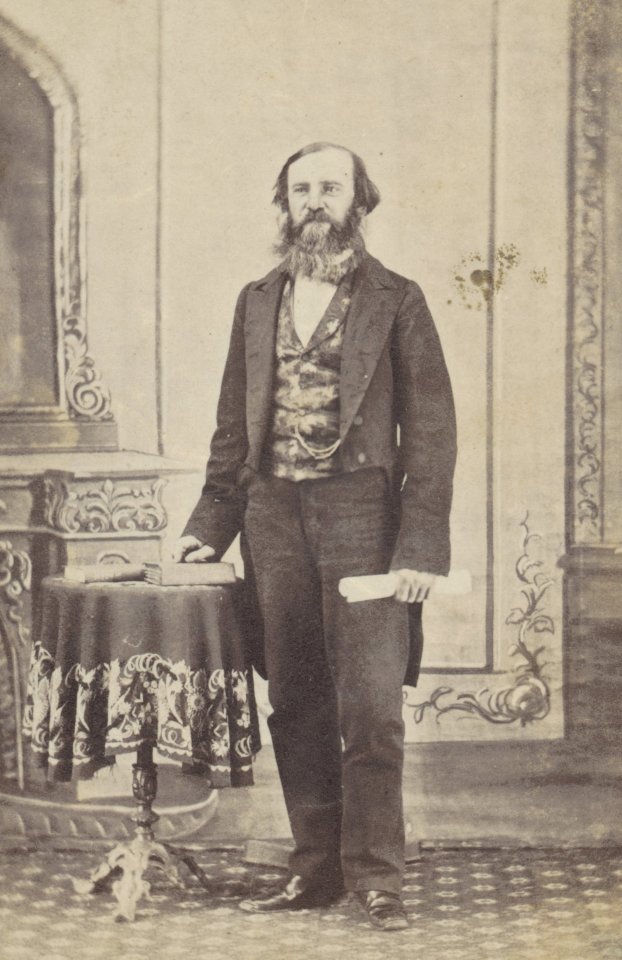
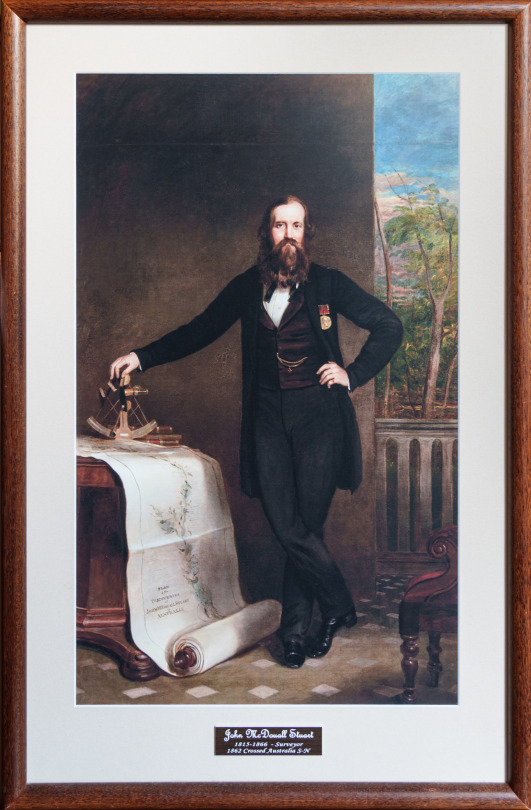
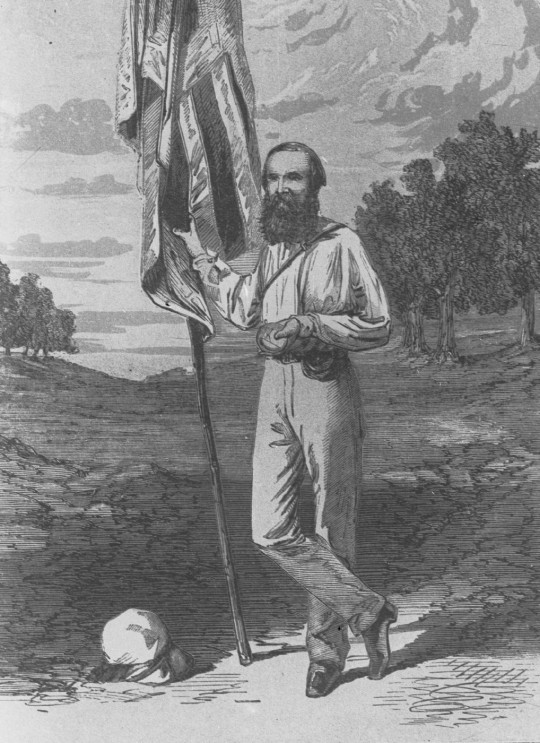

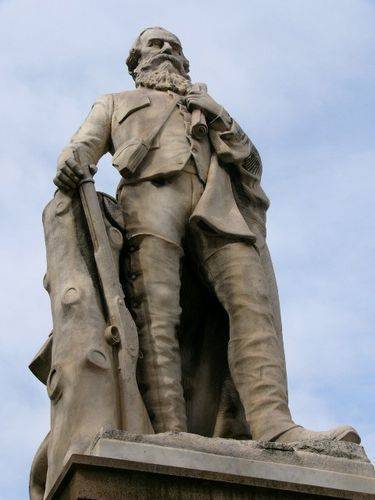
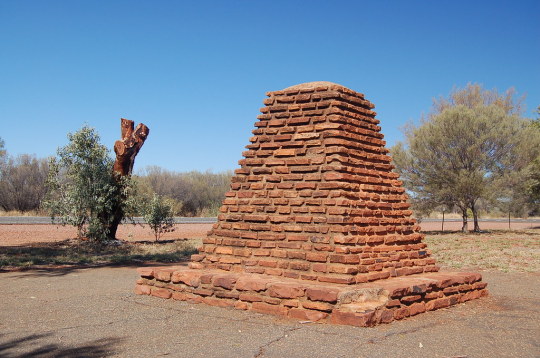

On September 7th 1815, explorer John McDouall Stuart was born in Dysart, Fife.
Descended from a family steeped in military service, Stuart was born in in a sixteenth-century home which now houses a museum in his honour, as seen in the pic. He was the son of army captain William Stuart and his wife Mary (née McDouall). Orphaned in his early teens, he attended the Scottish Naval and Military Academy, Edinburgh, and graduated as a civil engineer.
At the age of 23 he embarked on the Indus from Dundee, arriving at Holdfast Bay, South Australia, in January 1839. He entered the Government Survey Department and, despite primitive conditions in survey camps, found that nomadic life in the bush appealed to him. A man of small stature, his life became a constant battle against ill health and poverty. Assigned as draughtsman for the 1844-46 expedition of Captain Charles Sturt into the interior, Stuart gained valuable experience and received his leader’s full approbation. Sturt’s failure to reach the centre of the continent inspired Stuart’s later achievements.
Returning to Adelaide in January 1846, Stuart was incapacitated with scurvy for twelve months and moved to Port Lincoln for health reasons, while recovering he worked for fellow Scot and shipmate James Sinclair on his properties and tutored the Sinclair children.
In 1854 William Finke and the Chambers brothers, James and John, engaged him to survey leases and prospect for minerals in the northern Flinders Ranges. Between May 1858 and January 1860 Stuart led three expeditions into the Lake Eyre region, seeking new grazing lands and minerals for his sponsors.
In contrast to Sturt, Stuart travelled quickly with limited supplies. Horses were his only means of conveyance. On his first attempt to cross the continent, he reached the geographical centre of Australia on 22nd April 1860, accompanied by two companions and twelve horses --- a feat later described as ‘the greatest and pluckiest exploration ever accomplished’. He tried again the following year but it was not until 1862 that he finally made it to the northern shore.
In poor health Stuart returned to England in 1864, nearly blind and with a broken constitution. He died on 5th June 1866, a forgotten hero. He was buried at Kensal Green Cemetery, London, with a memorial stone erected by his sister Mary.
As a result of Stuart’s expeditions, the nature of the Red Centre was revealed, South Australia gained control of and settled the Northern Territory, and vast areas of the interior were opened up for European settlement. In 1872 the Adelaide-to-Darwin Overland Telegraph Line was completed along Stuart’s route.
His statue was erected in Victoria Square, Adelaide in 1904 and Central Mount Stuart, the Stuart Highway and Stuart Range are named in his honour. The John McDouall Stuart Society was founded in 1964 by descendants of his companions to perpetuate his name and achievements.
A second statue of Stuart can be found in Alice Spring. The statue has been hounded by controversy since it was gifted to the Alice Springs Town Council in 2010, with some saying the work is culturally insensitive. Protests accuse him of not asking permission to enter the land and of killing Arrernte people."You came to Mount Hay and you killed our mob," a letter from Aboriginal elders said. "You went to Attack Creek and you killed more of our mob. This is murder and we can't forget it." it continued.
The Australian Aboriginal singer Warren H Williams also spoke at a protest rally, mocking the size of the gun and calling for the statue to be removed.
"This fella has destroyed both Arrernte and Warramungu [people]...look at the statue, it's a big gun," he said.
"They put a statue up of him, but never asked anybody, even the white people in this town if they can put it up..."
There are numerous memorials to Stuart around South Australia.
8 notes
·
View notes
Text

Morris Nolton Turner (December 11, 1923 – January 25, 2014) was a cartoonist. He was the creator of the strip Wee Pals, the first American syndicated strip with a racially integrated cast of characters.
He moved on to cartoons during high school and he wanted to become a professional cartoonist. He worked on the school newspaper and was elected to the student council. He got his first training in cartooning via a correspondence course. He served as a mechanic with Tuskegee Airmen, his illustrations appeared in the newspaper Stars and Stripes. He created the comic strip Baker’s Helper.
He joined the Association of California Cartoonists and Gag Artists. Desiring to contribute to the ongoing Civil Rights Movement, he was encouraged by activists to create work based on his experiences.
He lamented the lack of minorities in cartoons, his first attempt, Dinky Fellas, featured an all-Black cast but found publication in only one newspaper. He reworked the strip and retired the Dinky Fellas name. The comic was retooled into Wee Pals. It was only carried by five newspapers, it was picked up by more than 100 after the assassination of Martin Luther King Jr.
He and his wife created a new segment to accompany Wee Pals. Titled “Soul Corner”.
He became a co-chairman of the White House Conference on Children and Youth. He appeared twice as a guest on Mister Rogers’ Neighborhood. His Kid Power animated series aired on Saturday mornings. Wee Pals on the Go was aired in San Francisco. He added characters of more ethnicities, as well as children with physical disabilities.
He and four other members of the National Cartoonist Society traveled to South Vietnam, where they spent a month drawing more than 3,000 caricatures of service personnel. For concerts by the Bay Area Little Symphony of Oakland, he drew pictures of the music and children in the audience. He launched the first in a series of Summer Art exhibitions at the East Oakland Youth Development Center.
He married Letha Mae Harvey (1946-94) they had one son, Morrie Jr. Late in life, his companion was Karol Trachtenburg. #africanhistory365 #africanexcellence
4 notes
·
View notes
Note
have you considered taking requests? Your writing is wicked good and I get it if you don’t. If you’re interested/ I was feeling a role reversal with a male Y/N being the civilian to joker’s female?
Role Reversal - Oneshot

Hello anon I love you so so much!! 🖤✨
First things first I never considered taking requests (I didn’t think anyone cared���😭😭) but THEN I read yours and I went down a spiral! You didn’t give me any details or perimeters, just an idea and I just took that as a sign to go crazy go stupid! It is my first time writing for a M!reader so please forgive me if I screwed that aspect up! I got carried away and I’m not ashamed!!
I’m so sorry this is almost three weeks old! I promise I didn’t put you on the back burner.. I just didn’t now where to go at one point SO! without further ado *drum roll*
Please note I was kinda inspired by The Neighborhood. I can envision Joker walking into this song sooo bad! Enjoy! 🖤✨
It was like any other day. Long hours spent sorting and moving heavy shipments within the warehouse.
Everyone had a role and stuck to it while maintaining playful banter whenever there was downtime in between work. You worked third shift, being wide awake when the common civilian was fast asleep. You handled the unseen portion of society's cycle of commerce. If you didn't work, these important goods would never arrive on time to where they needed to go.
A lot could happen overnight. It was your goal to make sure it did.
It didn't matter what was inside the boxes, your job was to prepare and load them into trucks. In your division just about everything from household electronics to stationary could pass through.
Tonight you signed up for misc. overtime. Ten-hour shifts with your fellow co-workers packing who knows what. It could be anything passing right under your nose.
Your manager; who's attitude was infamous within the warehouse and aptly nicknamed Frost, vaguely confirmed some goods were hot and reminded everyone to keep their heads down and not ask any questions tonight.
This was Gotham City. Not everything being moved was legal but a job was a job and this one paid the bills very well. You learned to keep your mouth shut a long time ago about the things you saw. The company had lawyers on standby should there be any liability issues. You wouldn't need them.
You were almost done with your shift without touching any hot items when a new order was assigned to your line in redacted print.
"Great." You sighed and waited for the goods to arrive. In the meantime, you read over the shipment details.
They were bound for a southern shipping container truck. It was common knowledge that the south warehouse processed all of the illegal goods. Walking back there freaked you out and you didn't like to stay longer than necessary to get a job done there.
The new order consisted of ten big wooden crates with ominous fragile stickers plastered all over. You programmed your mind to ignore the contents and simply do your job.
"Whatcha think is inside of 'em, huh, Y/n?" Your buddy Jazz asked. He'd been with the company for three years and still asked stupid questions. It was a miracle he was still employed.
You matched the serial numbers to your portable power pad and scoffed. "Don't know, don't care."
You read the loading bay, 3B, and called it out. "On me. Three, two..." You were flexing your muscles to lift on one when a loud blast came from the main entrance.
It brought with it a cloak of smoke but you could hear the various shouts and rapid gunfire closing in on your location. "Jazz! Get down!"
You dove to tackle him and avoided the spray of bullets that hit the wall behind you.
"Yo! What the f__k man!?" Jazz shoved you away to scramble to his feet. You were confused as to why he was so calm until approaching footsteps stole your attention.
They were calculated and sharp on the ear, almost like heels, which made you stop and think.
What sane woman would walk through gunfire? Let alone be at a warehouse this late at night. Regardless, three figures emerged through the smoke.
One was a tall man who carried an assault rifle and another who preferred a standard pistol— but both flanked a woman whose presence stopped your heart.
Gotham City's most notorious psychopath was here and she looked every bit the crime boss she claimed to be.
Her stilettos could kill a man while simultaneously adding height to her petite frame. The tailored pinstripe suit she wore was a deep plum with subtle details but it was nothing compared to the complex character wearing it.
Joker's long hair was dyed her signature forest green and tonight she kept it pushed back— so her face could be seen.
The scars. They were hideous and yet one couldn't look away no matter how hard they tried. Some accounts reported an ex-lover did it, another rumor claimed it was self-inflicted. Why any woman would carve her own face was beyond you.
Paired with her ghastly white makeup and dramatic smokey eyeshadow (that accented her light green eyes) she looked every bit the scary clown found in movies.
Joker came to a stop in front of Jazz and for a moment you thought she was gonna kill him outright until she smiled wide.
Her glossy black lipstick highlighted her unnaturally white teeth. "Well, well, well! Someone's been a very good boy."
Seeing coverage of her on tv was one thing opposed to the real deal. So many cops and eyewitnesses claimed she sounded like the devil, low and fierce, a true menace when demanding things yet if you closed your eyes, there was a slight childlike quality to her voice that put your mind at ease.
Delicate and alluring until she proved otherwise.
"Y-Yeah, I told ya I'm good for it! Don't believe me? It's all here." Jazz swept his arm towards the crates you two were supposed to be moving.
It took you all of three seconds to realize he was in on this. You decided to stay hidden behind a nearby forklift and listen. Joker nodded at her lackey to inspect. Thankfully he only cared about checking the goods and not looking over the side to find you. You saw him nod and move along to check the other crates down the line.
Jazz must've been promised compensation beforehand or he was simply one of the most cockiest dealers you ever seen. "Soooo. I helped secure the goods, gave solid intel." Joker's eyes darted over to him. "What's in it for me eh?"
Joker quickly replied. "I don't follow."
It was too quiet in the warehouse. The lackey finished his inspection and gave the all clear to his boss before resuming his flanking position. Everything was accounted for.
More men appeared from nowhere and began manually moving the crates into the 3B container. You looked on in horror as they added two more large crates into the container before closing it shut.
The truck was already backed into the loading bay. It wouldn't be hard for them to drive off with whatever was inside. What was Jazz thinking, messing with this lot? You peeked out of your hiding spot at the shakedown wrapping up. They were blocking the only exit and from here, things weren't looking too good for Jazz. He was outgunned and outmanned.
Joker had a frown on her face and from your position, you saw her acrylic nails twitch on the trigger of her gun.
The safety was off.
You knew Jazz had a hot temper and it didn't take much to set him off. You saw the signs in his posture. He took a deep breath and ticked his head to the side before speaking. "I'm askin' heh, where's my cut?"
You facepalmed. Jazz was incredibly stupid and Joker thought the same.
"Oh. Oh! You want a uhhh.. percentage! You hear that? He wants a cut!" Joker directed at her lackey holding the rifle. He chuckled and shook his head at the audacity.
Her heels clicked loudly on the warehouse floor as she walked closer to Jazz. Without warning, she grabbed his face and used her other hand to brandish a knife to it.
"You wanna cut? I'll give you a cut. You think I'd pay a lowlife informant like you?! Ha! Now, don't get me wrong. I'm veryyyy thankful for the intel. Really! I am! But uhh.. I don't need you anymore."
Joker spoke with such conviction she almost sounded sympathetic using her airy voice. It was like an angel speaking on the devil's behalf.
"And when I don't need things, they become loose ends! You wanna know what I do with loose ends?" She paused for dramatic effect.
Jazz looked ready to piss his pants but still had the balls to answer her. "N-No. No, I don't."
"Of course you don't know! So lemme tell you!"
You began to hyperventilate to the sound of Jazz choking on his own blood. A feminine giggle was also heard right before your co-worker's body slumped to the ground.
"I get rid of 'em." Joker replied to no one. "You three handle the rest and move out."
They all replied with their affirmatives and the area suddenly became vacant. You thought they were gone and opened your eyes.
You were still behind the forklift but took a peek around. The coast was clear. You breathed a sigh of relief. Tonight's shift was insane and you didn't know how to proceed any of it. How would you report this to HR?
You turned around to catch your breath but you saw Joker crouching down in front of you. "Holy shh.."'
Your heart was in your throat watching her stare at you. Up close like this you could really appreciate her domineering presence in all of its glory. She applied both fear and seduction to rule Gotham City and it worked wonders in her favor.
Before her disfigurement you had no doubt she was beautiful. Hell, to an extent she still was.
Full lips stained a jet black curled naturally at the corners. Joker had a heart shaped face with soft features but her eyes... God, her eyes. They drew you in with their pale color and they were framed by thick, dark lashes.
They brushed against her high cheekbones with each exaggerated blink. "That's it. Breathe for me now..."
Her voice coached you into regulating your heartbeat. She didn't seem hostile at present but you knew her reputation. Her mood could flip at the drop of a hat.
"Better?" She asked. Your voice hadn't returned yet so you nodded frantically. It seemed to appease her. "Good, that's good."
Her hand came up to cup your cheek and brush some of your h/c hair off of your forehead. She cooed at you gently when you flinched away from her touch.
"Now, now. None of that." Her heavy-lidded eyes were all you saw this close up. You chose to ignore Jazz's blood splattered across her face. She smelled like lighter fluid and roses; an obnoxiously sweet smell that clouded your senses.
You began to crave more of it against your better judgment.
She glanced down at your uniform and spotted your ID. A purple nail scraped the plastic surface right above your heart. "What are you so afraid of, Y/N L/N?" She even pronounced it right on the first try!
You stared straight into her eyes and answered truthfully. "You."
You were graced with her smile. It didn't matter that it was slicker than oil and also the same shade, it was the last thing you saw before you lost consciousness.

Your body felt groggy as if it were moving through molasses.
There were lights overhead that kept fading in and out. It felt like a weight was on your body. Like down feathers you wanted to cuddle into. Sure, it was comforting but something told you the pressure it was wrong. It didn't belong there.
Your instincts were correct when it kept touching your body unprovoked. It glided over your chest and arms and moved to the nape of your neck almost affectionately.
You shook your head, groaning, which only made the feeling worse. The unknown was kissing you and you couldn't deny that it felt absolutely amazing.
"Wait..." you slurred. Your hands moved through the heavy fog and came to a rest on a set of hips.
They began moving in earnest once you squeezed them tight. No amount of force could make them stop. Overtime they grew tired of your useless efforts and relocated your hands above your head. Then all bets were off.
You protested but a gentle voice shushed you. A lingering kiss burned your cheek as you slipped back into unconsciousness.

You woke up in the back of an SUV. The lights you saw before were street lamps shining through the sunroof.
Your head was still foggy but all of the night's events came back to you when a weight shifted on your chest. You looked down in horror as a head of green hair nuzzled in closer to you. A rush of roses hit you right as Joker glanced up at you.
How could someone so beautiful cause so much mass destruction? Surely this was a dream.
Without thinking about the consequences, you brushed a strand of her hair away from her face. Two seconds later she had your wrist pinned to the headrest and a knife at your throat.
"Aht aht, don't get all sentimental on me alright?" She eyed your lips hungrily until you threw all caution to the wind.
"S-Sorry it's just, you're so pretty. Wait, f__k! That's not true! Wait, you are.. but I mean that's not.." She watched you struggle with words with a raised brow.
"And I'm the crazy one." Joker murmured under her breath. This was pathetic to watch. "Spit. It. Out!"
You looked at her, ready to reply, when the entire SUV suddenly lurched forward. You were protected by your seatbelt but Joker almost went airborne if not for your quick response. You caught her around the waist and dragged her back down before she was sent flying towards the front.
"Have you ever heard of a seatbelt before?" You asked offhandedly. She rolled her eyes at your lame joke.
"Hey Boss! Your lover boy is here!" The driver shouted over his shoulder. It was like a switch went off.
Whatever cheeky moment you had with Joker was cast aside, the second her crush/enemy was confirmed tailing the SUV. "Bats?"
Joker instantly got excited and dove forward to program the sunroof open. The vehicle was going over eighty mph and the sudden wind spun her seaweed hued hair about like a hurricane, giving her perfect bed head vibes.
She ducked down to ask you. "How do I look?"
Your e/c eyes traveled from her toned legs in those sexy heels, to her clenched waist, all the way up to her deadly smile waiting for your opinion.
You couldn't lie no matter how dangerous it was to tell the truth. You were a warm blooded male for crying out loud and Joker was every bit an ideal female. Well, minus the face and personality. But her body?
"H-Hot. You look.. hot."
You waited with bated breath to be stabbed or worse, but Joker simply laughed and stood on the seat to poke her head out the sunroof.
What followed was typical Batman and Joker behavior. She taunted the caped cruiser while shouting out declarations of love, (it didn't make you jealous..) while firing off an array of guns which surprisingly included a bazooka, at the hero.
You panicked when the front seat passenger loaded it up inside the SUV before handing it off to Joker. "Hey hey hey hey! What the f—!"
The shockwave it made as it went off caused the SUV to lose control for a few scary minutes and it left you little choice but to wrap your arms around Joker's legs, lest she hurt herself in the chaos.
Her jovial laughter sent a clear message that she was having way too much fun to care about safety.
If Batman's swanky tank of a car wasn't enough, two GCPD cruisers flanked the speeding SUV and rammed both sides at once. And poor you was caught in the middle, swearing at the top of your lungs. More gunshots decorated the body of the car, one of them piercing through the back of the passenger's seat.
Joker's men in the front were mocking your attempts to get her to stop this madness and pull over.
She kicked your arms away and continued her antics until you had enough. You never thought things through during intense situations. You adopted tunnel vision until the problem was resolved.
You tuned out the police screaming to ceasefire as you poked your head out of the sunroof. Your voice lowered an octave as you yanked Joker's arm down. "Get back inside the car now!"
Her minty eyes were wide like saucers witnessing your dominant display and if you were more focused, you would've seen the incoming missile hurling towards the SUV. It obviously came from the Batmobile and in any other scenario, the shell would've been harmless.
Joker was a tough cookie and so were her goons. They could walk away from anything unscathed. You couldn't.
The missile hit dead on, sending the SUV swerving straight into a GCPD car and both flipped over multiple times upon impact. The crash site was hauntingly quiet.
The other police cars set up a perimeter a respective distance as the Batmobile screeched to a halt behind it. As broken glass and smoke settled, you came too fairly quickly. More quick thinking on your part saved you and Joker's life as you pulled her inside and shielded her head the moment her driver shouted, incoming!
You wished you kept your seatbelt on but things weren't always perfect in near death situations.
You took majority of the impact and knocked out your shoulder to save Joker's more fragile body. You lost your grip on her during the second roll and you had to wait until the SUV came to a stop, on its driver's side, to call out to her.
All she did was groan and turn her head away. Not good.
You saw a sea of flashing lights and wisely crawled out the door for help. This was supposed to be an average night at work, clocking overtime, not witnessing your co-worker make a bad arms deal and be actively involved in a high speed police chase. Wait till your friends heard about this on the eleven o'clock news.
You were still wearing your work uniform but the police still shouted at you to stop moving and put your hands on your head. You didn't get offended; you did emerge from The Joker's getaway vehicle. You could be hostile for all they knew.
Orders were orders and you raised your bloody hands up slowly but that didn't stop your mouth from moving.
"My name is Y/N L/N I work at Dixon Shipping Co. I'm unharmed! She's inside and unresponsive! Please... do.. something.."
You sighed as two officers made their way to your side. Too little too late. They fell dead from two gunshots each. It caused another wave of panic and you turned to watch a disoriented Joker pick off the remaining cops like flies.
Her head was bleeding and she was missing a shoe but God did she look drop dead gorgeous in her element. Her hair was a mess blocking her vision, but she made it to your side without any issue.
You thought the worst when she yanked you up to your feet and shoved the barrel of her gun to your head. Great, so her mood had turned sour, again.
This time Batman himself entered the scene. "Let him go, Joker." His modified voice sounded way cooler on GCN..
Joker wheezed out a laugh. "Oooooh! Is my Batsy jealous?! Don't know why, since you SHOT A MISSILE AT ME!" She pointed her gun at the dark knight. "You... hurt me.. Bats. All the time! Over and over! Y/n would never hurt me. Right, Y/n?"
Batman gave you a look that clearly meant, play along or die.
You watched as another fleet of cops arrived on scene. Batman waved them back. Joker was far more hostile than she'd ever been and her head injury was only making her current episode worse. She kept blinking her eyes and swaying on the spot, but she was in control as long as a weapon was in her hands.
You played along and made sure to establish physical contact with her. "That's right J-Joker. I would never, um h-hurt you. Ya gotta believe that baby." The endearment left a sour taste on your tongue but if she was buying the lie, hey.
You felt the gun waver on your temple and you cautiously moved to twist Joker around so she was facing you. She felt so small wrapped up in your arms, you never wanted to let her go.
You fussed over her wild hair and sucked your teeth at the nasty gash found on her head. "I told you to wear a seatbelt."
"Shut up." Joker groaned. You were only one privy to the tiny smile pinching at her black lips.
"I'm giving you one last warning, Joker. Let. Him. GO!"
And all of your hard work went down the drain.
Joker screamed and restrengthened her grip on the gun, now pointed squarely at your forehead.
"Or what Bats? Huh? Or what? You're gonna punish me? Ohhh I do love it when you do that." Joker tipped her head back and laughed. Each tap of her gun to your head felt like a code but you wrote it off as a coincidence.
Maybe she was growing on you or maybe she was just predictable. Fat chance of that. But either way you felt safe being held at gunpoint by this madwoman. You knew she wouldn't pull the trigger. Her finger was nowhere near it.
"I'm not here to play games, Joker."
Joker scoffed at her adversary. Batman was no fun; you however were. Joker gave you a lazy, pained smile and out of the blue kissed you right there in the middle of the street. You were too tired to deny her.
A spotlight highlighted the bizarre moment and made you pull away to look up at it.
A helicopter was hovering above and within seconds a rope was tossed over, headed your way. Joker used your dazed expression (her kisses were that electrifying) and the shock factor from her audience to grab onto the rope. She fired her automatic at the police department to make her grand escape. They never saw it coming.
One bullet clipped Batman's breastplate, stunning him if anything, but the effect was all the same. It bought her some time to make it a few feet off the ground to get away.
Joker's sultry laugh quickly drew Batman's attention. "Have fun boys! Don't hurt each other too much fightin' over little 'ol me!"
More gunshots and laughter rained down as you dove for cover and stumbled across a broken piece of mirror. Black lipstick marks were all over your face and neck. No wonder GCPD officers saw you as a threat before.
Joker sent a clear message: you were her new plaything. And you were quite fine with that new title.

#male reader#female joker#joker x y/n#joker fanfic#joker x you#joker x reader#chaos universe#dark knight joker#the dark knight joker#romance#joker au#cross posted on ao3#cross posted on wattpad#joker x male!reader#thanks anon!#thanks for the ask!#genderbent#gender bent fanfic
54 notes
·
View notes
Text
NJ Transit 40th Anniversary Weekend Extravaganza!
Pay your engineers and give them a contract.
Okay, now that that's out of the way...
This weekend I got to spend some time with my dad aboard NJT's 40th Anniversary Express, a special train they put together in conjunction with the United Railroad Historical Society of New Jersey to commemorate 40 years of NJT's rail service. Normally I'd have just been content to watch, but they hooked me with a GG1 reference so naturally I had to go because I will do anything for a GG1.

The URHS of NJ loaned the Hickory Creek out for the event, along with a few other passenger cars they own. It was weird to see it at Penn Station instead of in Grand Central Terminal, but they still rolled out the red carpet for it as if it was attached to the 20th Century Limited. (This is where we get the phrase "red carpet treatment" from, by the way. It has nothing to do with Hollywood and everything to do with one crack passenger express train.)
I did not ride in the Hickory Creek itself because I do not have that sort of money, but Dad and I were in the Tavern Lounge No. 43, another New York Central car. It was a lovely ride.

The highlight of the trip was in South Amboy. Historically, electrification of the North Jersey Coast Line ended here. Today, it ends in Long Branch. Here's where the GG1s come in. There would be an engine change at South Amboy. The GG1s, electric locomotives, would be switched out for other locomotives to go further south. It was steam at first, and sadly became diesel later. Yesterday, they recreated this engine switch for us, complete with an NJT heritage unit painted to look like a GG1. This is the closest I'll likely get to seeing one running within my lifetime, so I'll cherish it.

The engine change. NJT 4636 stood in for my beloved GG1s, and two of the first locomotives built for NJ Transit, a pair of F40-PH2s (4119 and 4120), took over. You rarely see the latter in passenger service these days because they usually pull work trains, but they're the last two members of their class in NJT service.

Much to everyone's delight, we got to watch some brakeman work in action, because they manually flipped the switches. Note the heavy-duty gloves the conductor is wearing for this purpose.

It takes quite a bit of setup...
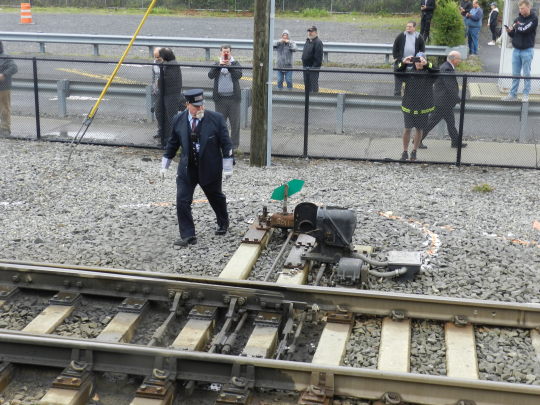
All clear!
Once the locomotives were swapped, we all boarded again and went on down to Bay Head. Since it was cold and rainy out, a few of us had some hot chocolate, which hit the spot and was incredibly wonderful.

Eventually, we made it to Bay Head. This is how I found out the president of NJ Transit was on the train with us, because the NJT engineers are ready to strike because there's no contract right now, and a group of them were protesting down at Bay Head because they knew he'd have to see them. Excellent move.
At Bay Head, we got to go around the loop in Bay Head Yard, something passengers don't normally get to do.

So we had views that most people don't get to have, and that was really cool.


At Bay Head, they fed us and gave us NJT swag. There were also some vintage buses from Public Service there, which was great because nobody stopped me from getting into the driver's seat of them.
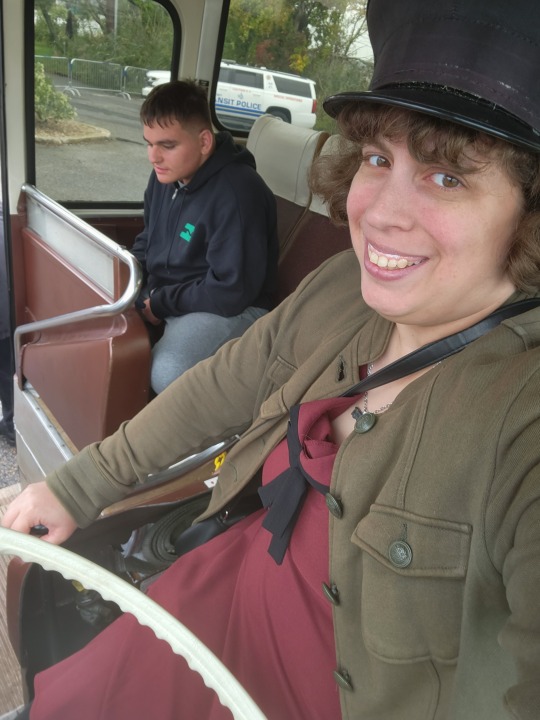
My right hand is on the gearshift in this photo - it was huge and came out of the floor. Neither bus had power steering - that's a relatively new feature in motor vehicles.
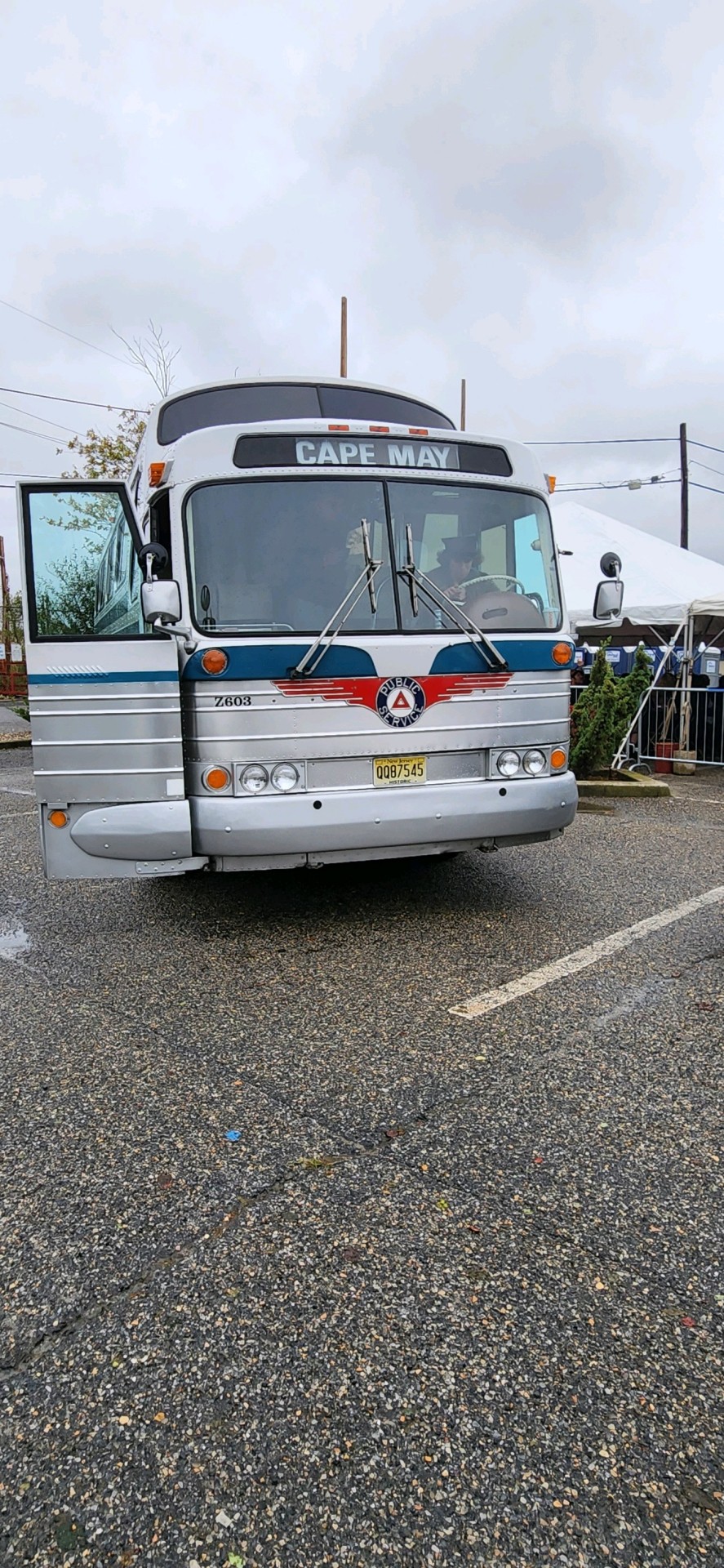
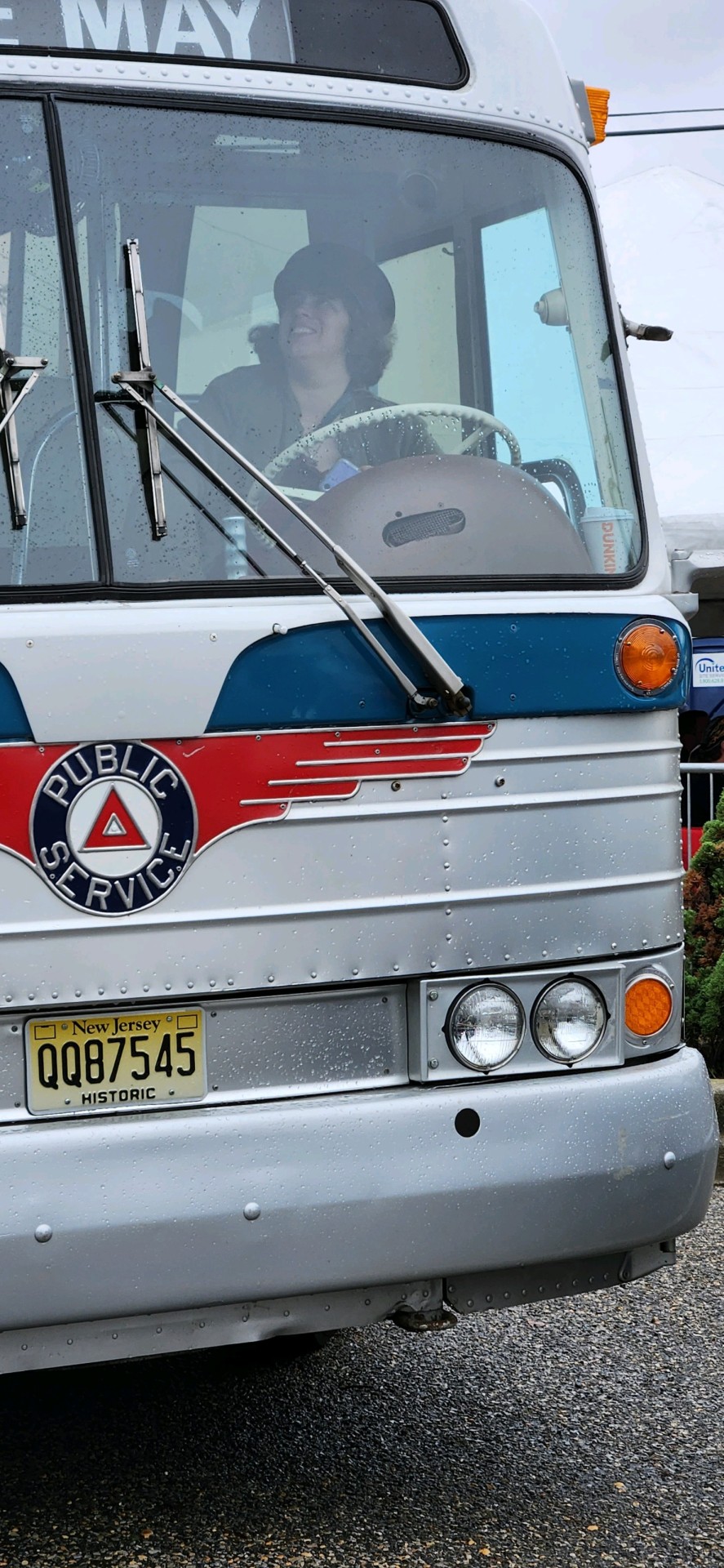
I can and will attempt to drive anything.
Back to trains - after lunch, everyone got back aboard and the 40th Anniversary Express made its way back up north to Newark Penn Station. Whilst we were at Newark, we were allowed to get out and take some photos, so I investigated the staff car and was delighted to see that it had a conference table with a PRR K4 pictured above it.
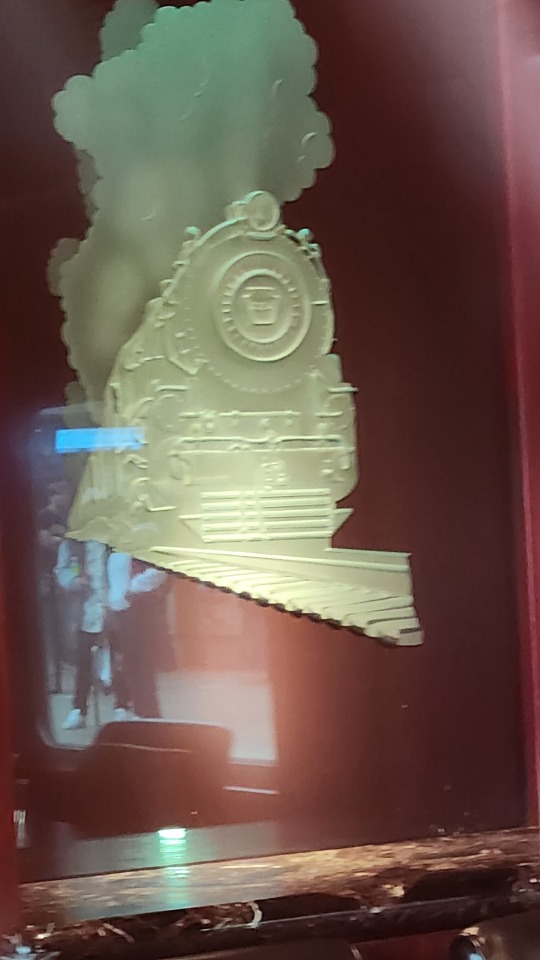
You know me, I love my 4-6-2 Pacifics.
Eventually, the train came into Hoboken Terminal, and that was the end of day one.
Today, the entire heritage fleet was on display at Hoboken Terminal, so I made my way back for more photos.
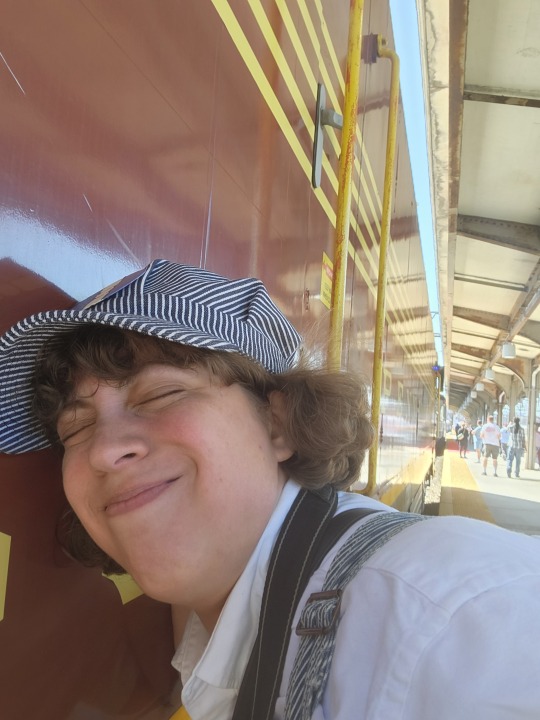
I love GG1s and wanted to thank my new friend for giving me the opportunity to come so close to that experience yesterday.

4101 and 4109 are the surviving sisters of NJT 4100, a locomotive I'm rather attached to. It was nice to get good photos of them instead of the ones I usually have to snap through the window when I'm actually out on the rails!

Erie-Lackawanna 3372 is a labor of love for the URHS of NJ. They've done a beautiful job restoring her so far, but there's still a lot of work left to do.

The thing that really did me in was this old Pennsy diesel here, an E8A numbered 5711. She's in incredible condition for something built in 1952, and they had a cast of an old Penn Station eagle next to her, too, just to break my heart into a million pieces because I'll never be over what happened to Penn Station.
In all, I had an amazing weekend, and NJT and the URHS of NJ knocked it out of the park with this. It was just wonderful to be surrounded by other railfans for a couple of days.
Some other highlights:
Talked about trains the entire ride with the folks in our car. At one point we all got to sharing cat photos. An older couple had a cat named Lake, short for Lake Shore Limited. I cannot tell you how much that delighted me.
I love being around other railfans. It's one of the rare places I can be myself, since there's inevitably going to be a lot of other autistic people there besides me so I don't have to mask. I cannot even begin to articulate what it means to me to be in a place where I don't have to mask.
The hobby has actually changed a lot since I was a little kid - and in a good way. I wasn't the only woman there, for one. I was still greatly outnumbered gender-wise, but there are a lot more women in the hobby now, and it's also a lot more racially diverse than it was back then. Additionally, I saw a LOT of young people - it's going strong! It doesn't feel like it's being gatekept by the old white men anymore. It's really wonderful. Trains are for everyone. They always were, but now you can visibly see it.
When we were on the platform at South Amboy getting set up to take photos, someone yelled "Everybody smile!" behind me and I nearly died. Because, you know:

Whoever you are, give me your phone number.
As a final addendum, of course I brought them with me, as per usual when I go out to do railroading stuff. Here they are seated in Tavern Lounge 43!
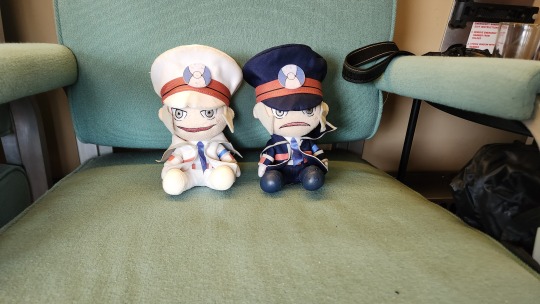
This was just an absolute banger of a weekend and I hope more events like this happen because it's so fun to engage with history hands-on and see other people who care about it as much as you do. It's the best! Perfect!
48 notes
·
View notes